Paul van Yperen's Blog, page 146
October 6, 2021
All'ombra di un trono (1921)
One of the gems to be featured in the 40th edition of Le Giornate del Cinema Muto, the international silent-film festival of Pordenone, is a preview of the Ruritania retrospective in 2022 with All'ombra di un trono/In the Shadow of a Throne (1921). This Italian melodrama was directed by Carmine Gallone and starring his wife, Polish diva Soava Gallone. The couple made All'ombra di un trono for their own production company Films Gallone. Other actors in the cast were Umberto Casilini, Piero Schiavazzi and the child actress Marcella Sabbatini.
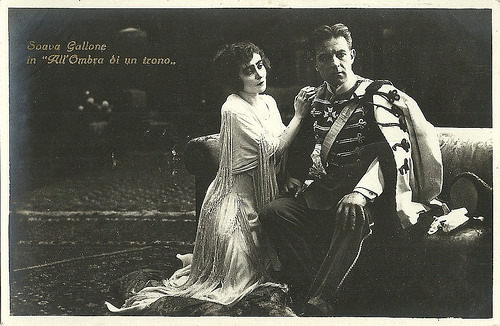
Italian postcard by G.B. Falci, Milano. Photo: publicity still for All'ombra di un trono/In the Shadow of a Throne (Carmine Gallone, 1921).
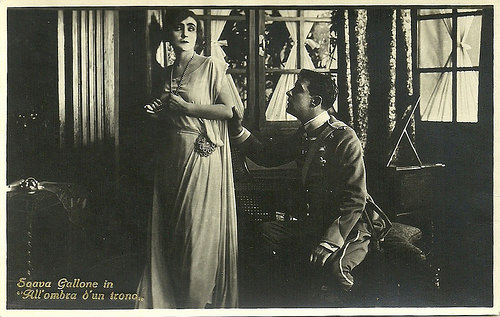
Italian postcard by G.B. Falci, Milano, no. 94. Photo: publicity still for All'ombra di un trono/In the Shadow of a Throne (Carmine Gallone, 1921).
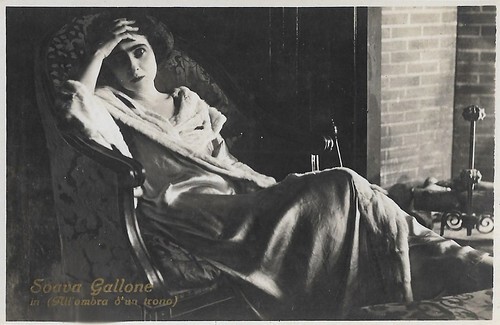
Italian postcard by G.B. Falci, Milano, no. 112. Photo: Films Gallone. Soava Gallone in All'ombra di un trono/In the Shadow of a Throne (Carmine Gallone, 1921).

Italian postcard by G.B. Falci, Milano, no. 224. Photo: publicity still for All'ombra di un trono/In the Shadow of a Throne (Carmine Gallone, 1921).
Ruritania-like story
All'ombra di un trono/In the Shadow of a Throne aka L'Ombra di un trono (Carmine Gallone, 1921) was based on 'Fleur d'ombre' (Shadow flower) a French novel by Charles Folly.
When the legitimate heir to a throne has mysteriously killed himself, his brother (Piero Schiavazzi) becomes king. The iron law obliges the young and inexpert prince to abandon his affair with a bourgeois girl ( Soava Gallone ), with whom he is in love.
The renouncement of (but then revocation) of real love, the court intrigues, and a final duel are the ingredients of this Ruritania-like story.
All'ombra di un trono/In the Shadow of a Throne was released in Italy only in 1923. While the press thought it was outdated, audiences flocked to see the film.
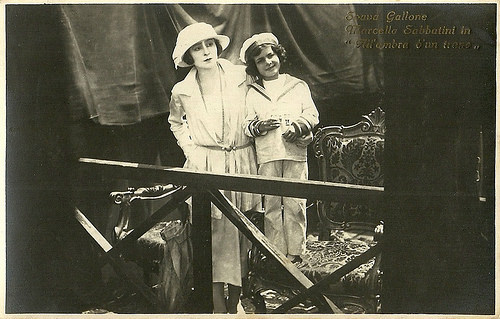
Italian postcard by G.B. Falci, Milano, no. 115. Photo: publicity still for All'ombra di un trono/In the Shadow of a Throne (Carmine Gallone, 1921).
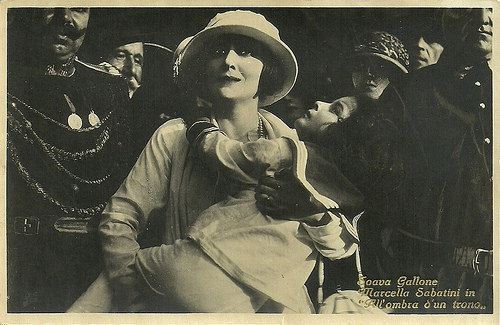
Italian postcard by G.B. Falci, Milano, no. 117. Photo: publicity still for All'ombra di un trono/In the Shadow of a Throne (Carmine Gallone, 1921).
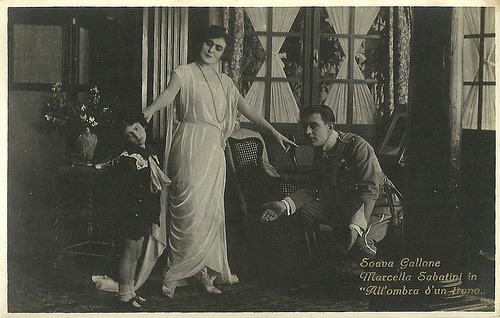
Italian postcard by G.B. Falci, Milano, no. 172. Photo: publicity still for All'ombra di un trono/In the Shadow of a Throne (Carmine Gallone, 1921).
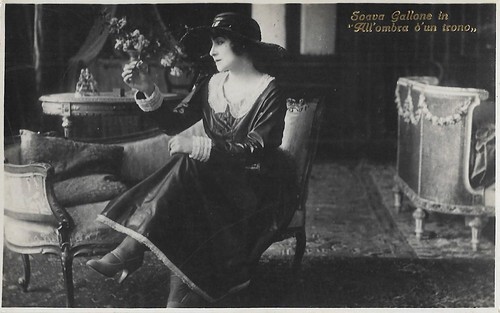
Italian postcard by G.B. Falci, Milano, no. 217. Photo: Films Gallone. Soava Gallone in All'ombra di un trono/In the Shadow of a Throne (Carmine Gallone, 1921).
.
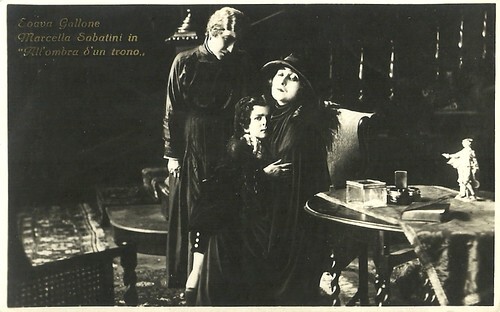
Italian postcard by G.B. Falci, Milano. Photo: Films Gallone. Soava Gallone and Marcella Sabbatini in All'ombra di un trono/In the Shadow of a Throne (Carmine Gallone, 1921).
Sources: Vittorio Martinelli (Il cinema muto italiano 1921-1922 - Italian) and IMDb.

Italian postcard by G.B. Falci, Milano. Photo: publicity still for All'ombra di un trono/In the Shadow of a Throne (Carmine Gallone, 1921).

Italian postcard by G.B. Falci, Milano, no. 94. Photo: publicity still for All'ombra di un trono/In the Shadow of a Throne (Carmine Gallone, 1921).

Italian postcard by G.B. Falci, Milano, no. 112. Photo: Films Gallone. Soava Gallone in All'ombra di un trono/In the Shadow of a Throne (Carmine Gallone, 1921).

Italian postcard by G.B. Falci, Milano, no. 224. Photo: publicity still for All'ombra di un trono/In the Shadow of a Throne (Carmine Gallone, 1921).
Ruritania-like story
All'ombra di un trono/In the Shadow of a Throne aka L'Ombra di un trono (Carmine Gallone, 1921) was based on 'Fleur d'ombre' (Shadow flower) a French novel by Charles Folly.
When the legitimate heir to a throne has mysteriously killed himself, his brother (Piero Schiavazzi) becomes king. The iron law obliges the young and inexpert prince to abandon his affair with a bourgeois girl ( Soava Gallone ), with whom he is in love.
The renouncement of (but then revocation) of real love, the court intrigues, and a final duel are the ingredients of this Ruritania-like story.
All'ombra di un trono/In the Shadow of a Throne was released in Italy only in 1923. While the press thought it was outdated, audiences flocked to see the film.

Italian postcard by G.B. Falci, Milano, no. 115. Photo: publicity still for All'ombra di un trono/In the Shadow of a Throne (Carmine Gallone, 1921).

Italian postcard by G.B. Falci, Milano, no. 117. Photo: publicity still for All'ombra di un trono/In the Shadow of a Throne (Carmine Gallone, 1921).

Italian postcard by G.B. Falci, Milano, no. 172. Photo: publicity still for All'ombra di un trono/In the Shadow of a Throne (Carmine Gallone, 1921).

Italian postcard by G.B. Falci, Milano, no. 217. Photo: Films Gallone. Soava Gallone in All'ombra di un trono/In the Shadow of a Throne (Carmine Gallone, 1921).
.

Italian postcard by G.B. Falci, Milano. Photo: Films Gallone. Soava Gallone and Marcella Sabbatini in All'ombra di un trono/In the Shadow of a Throne (Carmine Gallone, 1921).
Sources: Vittorio Martinelli (Il cinema muto italiano 1921-1922 - Italian) and IMDb.
Published on October 06, 2021 22:00
October 5, 2021
Ita Rina
At the mid-week event of Le Giornate del Cinema Muto, the international silent-film festival of Pordenone, a celebration of sensuality is on offer. The Czech drama Erotikon (1929), directed by Gustav Machatý, is a touchstone of the late silent era and has been scored by Slovenian composer Andrej Goricar for eight musicians. The Star of the film is the Slovenian actress Ita Rina (1907-1979) who was one of the major film stars in Germany and Czechoslovakia in the late 1920s and early 1930s.
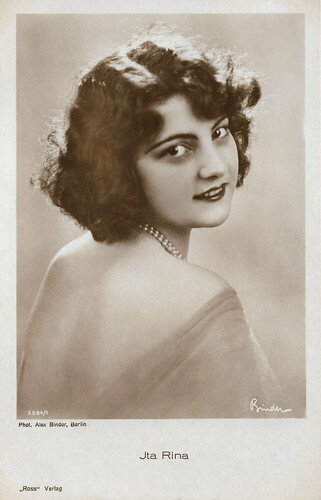
German postcard by Ross Verlag, no. 3324/1, 1928-1929. Photo: Alex Binder, Berlin.
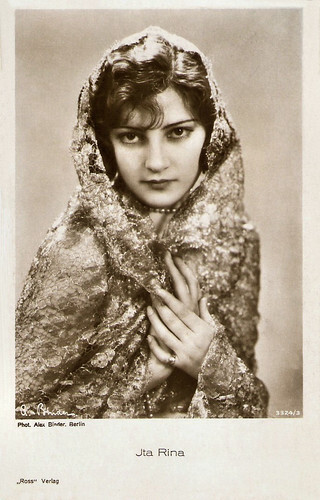
German postcard by Ross Verlag, no. 3324/3, 1928-1929. Photo: Alex Binder, Berlin.
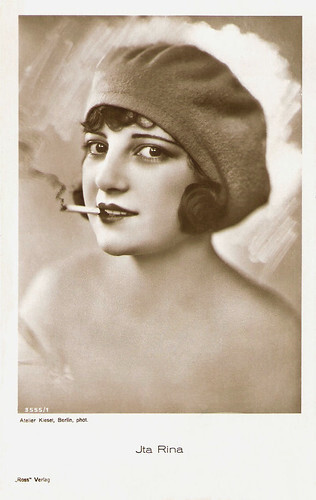
German postcard by Ross Verlag, no. 3555/1, 1928-1929. Photo: Kiesel, Berlin.
Miss Slovenia
Ita Rina was born as Italina Lida ‘Ida’ Kravanja in the small town of Divača (then Austro-Hungarian Empire, later Yugoslavia, now Slovenia) in 1907. She was the first daughter of Jožef and Marija Kravanja. Rina had a younger sister Danica.
Shortly after the outbreak of World War I, the family moved to Ljubljana, where Rina matriculated in 1923. Her dream was to become an actress. In October 1926, Slavic People magazine organized a beauty pageant for a Miss to represent Yugoslavia at the Miss Europe contest. The attractive nineteen-year-old secretly entered the beauty contest, not telling anyone at home.
She was crowned Miss Slovenia and should travel to the final event for Miss Yugoslavia in Zagreb. However, her mother did not want to let her go to Zagreb. After a group visit of the Slovenian delegation, Marija Kravanja slacked. Unfortunately, when Rina arrived in Zagreb, the jury was already choosing the most beautiful of three finalists.
However, she was noticed by Adolf Müller, the owner of Balkan Palace cinema in Zagreb. He sent her photographs to German film producer Peter Ostermayer, who invited her to come to Germany. As her mother did not want to let her go to Berlin, Rina ran away from home and arrived in Berlin in 1927.
After her first audition, she had classes in acting, diction, dancing, driving, and riding. She made her film debut in the leading role in Was die Kinder ihren Eltern verschweigen/What Do Children Hide from Their Parents (Franz Osten, 1927) with Mary Johnson . After some small film roles in 1927 and 1928, the critics noticed her in Das letzte Souper/The Last Supper (Mario Bonnard, 1928) starring Marcella Albani .
That same year, Rina met her future husband Miodrag Đorđević, a student. Her big breakthrough came the following year, opposite Olaf Fjord in Erotikon/Seduction (1929), directed by Gustav Machatý. She was starring in the leading female role, Andrea. The film was a great success but also upset some moral and Christian organisations.
Robert J. Maxwell at IMDb loved Rina’s performance: “She's a beauty by any metric. Her eyes are slanted and large. When she's excited, the irises are surrounded entirely by the whites. I can't do that. I just tried it in the mirror. And her nose is exquisite. It begins between her eyebrows, disregarding the usual need for a glabella, and cleaves her features in two. That nose is magnetic, exactly the right size for nibbling.”
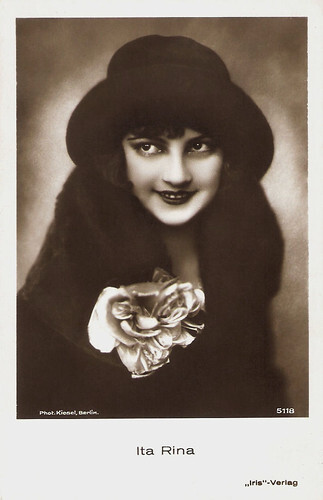
Austrian postcard by Iris-Verlag, no. 5118. Photo: Kiesel, Berlin.
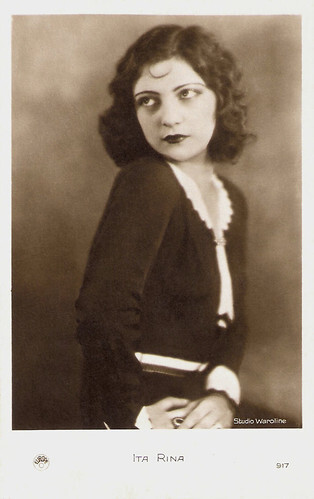
French postcard by Europe, no. 917. Photo: Studio Waroline.
Atomic war bride
In 1930, Ita Rina acted in three films, the most notable being the first talking Czech film Tonka Šibenice/Gallows Toni (Karl Anton, 1930). The title part in this film is often named as her best role. In 1931, she married Miodrag Đorđević and changed her religion from Roman Catholic to Serbian Orthodox. Rina was baptised in the Russian Orthodox Church, and also got her new Orthodox name, Tamara Đorđević.
Now at the height of her career, she earned 15,000 marks per month and was an idol to teenagers as well as to modern emancipated women. The same year, Rina was given an offer from Hollywood, but her husband forced her to choose between her career and their marriage. Rina chose to stay with him. Although she had announced her retirement from the cinema, she acted until the outbreak of World War II.
Her last film appearance was in the crime drama Zentrale Rio/Central Rio (Erich Engels, 1939) co-starring Leny Marenbach and Camilla Horn . Rina and her husband settled in Belgrade. In 1940, she gave birth to their son Milan. After the bombing of Belgrade in 1941, the family moved to Vrnjačka Banja, where Rina gave birth to a daughter, Tijana. They moved back to Belgrade after the end of World War II in 1945.
Although she was promised several roles in Yugoslav films, all projects were cancelled. After she had written to President Tito, Rina began working as a co-production advisor for Avala Film. She returned to the silver screen once, in the Science-Fiction drama Rat/Atomic War Bride (Veljko Bulajić, 1960). The film, which deals with the horrors of the atomic weapon era, won three Golden Arena awards at the 1960 Pula Film Festival, including for Best Director (Veljko Bulajić), Best Actor (Antun Vrdoljak) and Best Scenography (Duško Jeričević), and was nominated for the Golden Lion award at the 1960 Venice Film Festival. It was her last role.
As she was ill of asthma, Rina and her husband moved to Budva (then Yugoslavia, now Montenegro) in 1967. There, she was taking care of her husband, who was ill of sclerosis. Ita Rina died in 1979 in Budva of an asthmatic attack. She was buried a few days later in Belgrade, in the presence of numerous film artists, admirers, friends, and family.
A decade ago, the Slovenian Cinematheque mounted a permanent exhibition of the actress’s photos and posters at the Škrjateljnova domačija, the house where she was born. The Slovenian Cinematheque also marked the recent centennial of her birth by reprinting a monograph on her life and work, now in an extended edition complete with English translations.
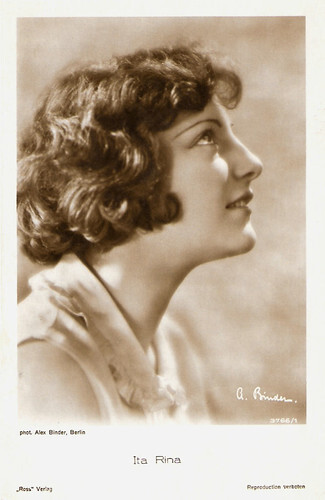
German postcard by Ross Verlag, no. 3766/1, 1928-1929. Photo: Alex Binder, Berlin.
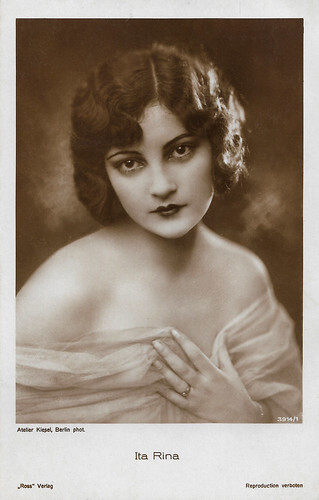
German postcard by Ross Verlag, no. 3914/1, 1928-1929. Photo: Kiesel, Berlin.
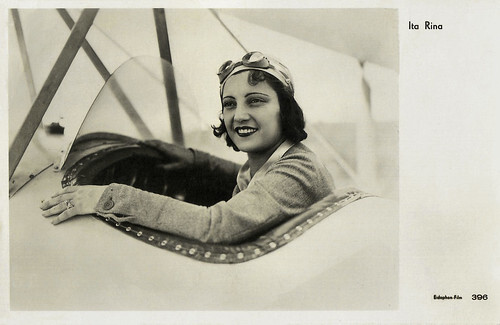
Dutch postcard by JosPe, no. 396. Photo: Eidophon-Film. Ita Rina in Das Lied der Schwarzen Berge/Fantom Durmitora/The Song of the Black Mountains (K. Breiness, Hans Natge, 1933).
Sources: Slovenia.si, Wikipedia, and .

German postcard by Ross Verlag, no. 3324/1, 1928-1929. Photo: Alex Binder, Berlin.

German postcard by Ross Verlag, no. 3324/3, 1928-1929. Photo: Alex Binder, Berlin.

German postcard by Ross Verlag, no. 3555/1, 1928-1929. Photo: Kiesel, Berlin.
Miss Slovenia
Ita Rina was born as Italina Lida ‘Ida’ Kravanja in the small town of Divača (then Austro-Hungarian Empire, later Yugoslavia, now Slovenia) in 1907. She was the first daughter of Jožef and Marija Kravanja. Rina had a younger sister Danica.
Shortly after the outbreak of World War I, the family moved to Ljubljana, where Rina matriculated in 1923. Her dream was to become an actress. In October 1926, Slavic People magazine organized a beauty pageant for a Miss to represent Yugoslavia at the Miss Europe contest. The attractive nineteen-year-old secretly entered the beauty contest, not telling anyone at home.
She was crowned Miss Slovenia and should travel to the final event for Miss Yugoslavia in Zagreb. However, her mother did not want to let her go to Zagreb. After a group visit of the Slovenian delegation, Marija Kravanja slacked. Unfortunately, when Rina arrived in Zagreb, the jury was already choosing the most beautiful of three finalists.
However, she was noticed by Adolf Müller, the owner of Balkan Palace cinema in Zagreb. He sent her photographs to German film producer Peter Ostermayer, who invited her to come to Germany. As her mother did not want to let her go to Berlin, Rina ran away from home and arrived in Berlin in 1927.
After her first audition, she had classes in acting, diction, dancing, driving, and riding. She made her film debut in the leading role in Was die Kinder ihren Eltern verschweigen/What Do Children Hide from Their Parents (Franz Osten, 1927) with Mary Johnson . After some small film roles in 1927 and 1928, the critics noticed her in Das letzte Souper/The Last Supper (Mario Bonnard, 1928) starring Marcella Albani .
That same year, Rina met her future husband Miodrag Đorđević, a student. Her big breakthrough came the following year, opposite Olaf Fjord in Erotikon/Seduction (1929), directed by Gustav Machatý. She was starring in the leading female role, Andrea. The film was a great success but also upset some moral and Christian organisations.
Robert J. Maxwell at IMDb loved Rina’s performance: “She's a beauty by any metric. Her eyes are slanted and large. When she's excited, the irises are surrounded entirely by the whites. I can't do that. I just tried it in the mirror. And her nose is exquisite. It begins between her eyebrows, disregarding the usual need for a glabella, and cleaves her features in two. That nose is magnetic, exactly the right size for nibbling.”

Austrian postcard by Iris-Verlag, no. 5118. Photo: Kiesel, Berlin.

French postcard by Europe, no. 917. Photo: Studio Waroline.
Atomic war bride
In 1930, Ita Rina acted in three films, the most notable being the first talking Czech film Tonka Šibenice/Gallows Toni (Karl Anton, 1930). The title part in this film is often named as her best role. In 1931, she married Miodrag Đorđević and changed her religion from Roman Catholic to Serbian Orthodox. Rina was baptised in the Russian Orthodox Church, and also got her new Orthodox name, Tamara Đorđević.
Now at the height of her career, she earned 15,000 marks per month and was an idol to teenagers as well as to modern emancipated women. The same year, Rina was given an offer from Hollywood, but her husband forced her to choose between her career and their marriage. Rina chose to stay with him. Although she had announced her retirement from the cinema, she acted until the outbreak of World War II.
Her last film appearance was in the crime drama Zentrale Rio/Central Rio (Erich Engels, 1939) co-starring Leny Marenbach and Camilla Horn . Rina and her husband settled in Belgrade. In 1940, she gave birth to their son Milan. After the bombing of Belgrade in 1941, the family moved to Vrnjačka Banja, where Rina gave birth to a daughter, Tijana. They moved back to Belgrade after the end of World War II in 1945.
Although she was promised several roles in Yugoslav films, all projects were cancelled. After she had written to President Tito, Rina began working as a co-production advisor for Avala Film. She returned to the silver screen once, in the Science-Fiction drama Rat/Atomic War Bride (Veljko Bulajić, 1960). The film, which deals with the horrors of the atomic weapon era, won three Golden Arena awards at the 1960 Pula Film Festival, including for Best Director (Veljko Bulajić), Best Actor (Antun Vrdoljak) and Best Scenography (Duško Jeričević), and was nominated for the Golden Lion award at the 1960 Venice Film Festival. It was her last role.
As she was ill of asthma, Rina and her husband moved to Budva (then Yugoslavia, now Montenegro) in 1967. There, she was taking care of her husband, who was ill of sclerosis. Ita Rina died in 1979 in Budva of an asthmatic attack. She was buried a few days later in Belgrade, in the presence of numerous film artists, admirers, friends, and family.
A decade ago, the Slovenian Cinematheque mounted a permanent exhibition of the actress’s photos and posters at the Škrjateljnova domačija, the house where she was born. The Slovenian Cinematheque also marked the recent centennial of her birth by reprinting a monograph on her life and work, now in an extended edition complete with English translations.

German postcard by Ross Verlag, no. 3766/1, 1928-1929. Photo: Alex Binder, Berlin.

German postcard by Ross Verlag, no. 3914/1, 1928-1929. Photo: Kiesel, Berlin.

Dutch postcard by JosPe, no. 396. Photo: Eidophon-Film. Ita Rina in Das Lied der Schwarzen Berge/Fantom Durmitora/The Song of the Black Mountains (K. Breiness, Hans Natge, 1933).
Sources: Slovenia.si, Wikipedia, and .
Published on October 05, 2021 22:00
October 4, 2021
The comic genius of Max Linder
French comedian Max Linder (1883-1925) was the star of the first edition of Le Giornate del Cinema Muto in 1982, the international silent film festival of Pordenone. This year, Linder returns in Pordenone with his last film, Der Zirkuskönig/King of the Circus (Max Linder, Édouard-Émile Violet, 1924) with Vilma Bánky, restored by Lobster films of Paris. With his trademark silk hat, stick and moustache, Linder was an influential pioneer of silent film. He was largely responsible for the creation of the classic slapstick comedy.
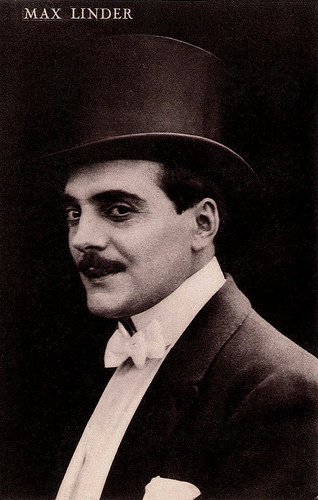
French postcard by Helio Paul et Vigier, Paris. Publicity card for the Pathé-Baby projector.
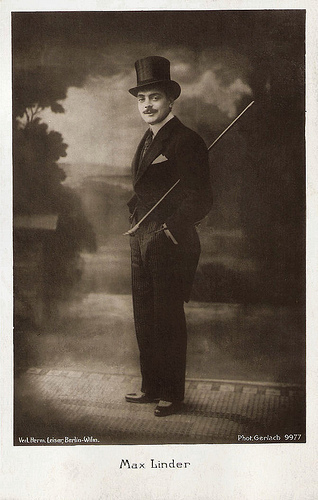
German postcard by Verlag Herm. Leiser, no. 9977. Photo: Gerlach.
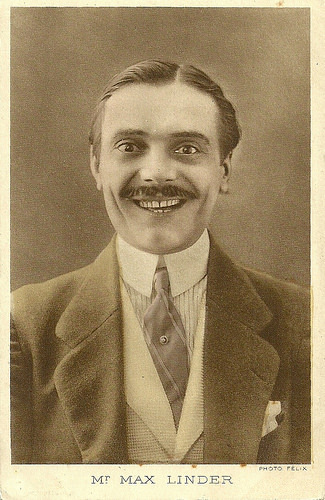
French postcard by Pathé Frères. Photo: Felix.
Gentleman Max
Max Linder was born Gabriel-Maximilien Leuvielle in Saint-Loubès, France in 1883 to a Jewish wine-growing family.
He grew up with a passion for the stage and at 17 he dropped out of school in order to join a touring theatre troupe, which did not please his parents.
While working in Paris as an actor in the theatre and vaudeville, Leuvielle became fascinated with motion pictures. In 1905 he took a job with Pathé Frères and in the following years, he became a comedic actor, director, screenwriter, as well as a producer under the stage name, Max Linder.
His debut was Première sortie/His First Night Out (Louis J. Gasnier, 1905). He created what was probably the first identifiable film character: ‘Max’, an elegant, joyful, romantic, top-hatted dandy.
Max appeared for the first time in Debuts d'un patineur/The Unskillful Skater (Louis J. Gasnier, 1907) and would return in successive situation comedies. ‘Gentleman Max’ was frequently in hot water because of his penchant for beautiful women and the good life.
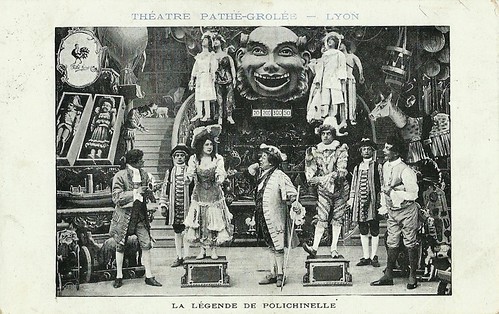
French postcard for La légende de Polichinelle (Albert Capellani, Pathé frères 1907). With Max Linder as Polichinelle. Théâtre Pathé Grolée, Lyon. Polichinelle is an automaton in love with a cute doll in the same shop. When the doll is sold, a fairy helps Polichinelle following her and after a series of wild adventures he arrives at the house of the buyer just in time to save the doll from being burned.
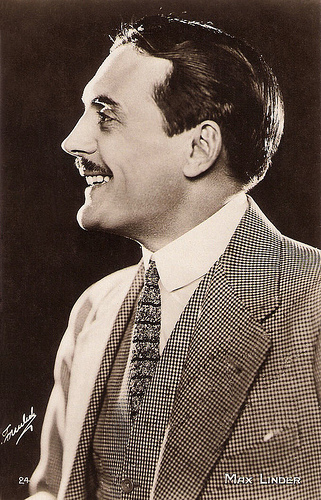
French postcard by Cinémagazine, no. 24.
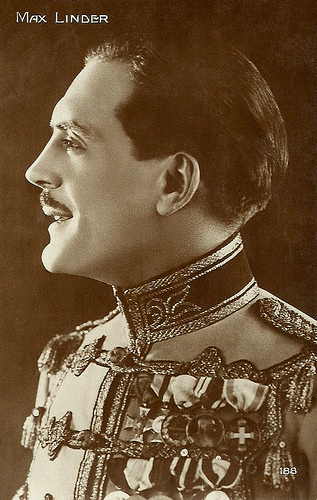
French postcard by Cinémagazine, no. 188.
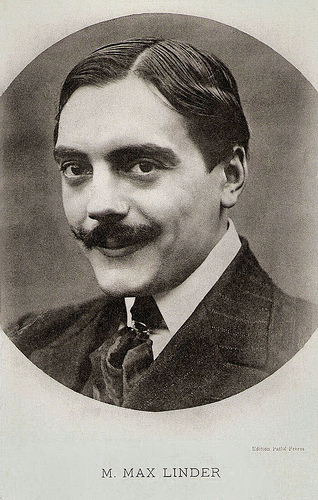
French postcard by Edition Pathé Frères.
Comedy Star No. 1
After comedian André Deed went to Italy, Max Linder moved up and became the comedy star no. 1 for Pathé.
In 1910 he shot one comedy each week. By 1911, Linder was directing all his own films as well as writing the script and the universality of silent films brought Linder fame and fortune throughout Europe. By 1912, he was the highest-paid film star in the world, with an unprecedented salary of one million francs.
His success didn't have any limits: whether Spain, Germany, Italy, or Russia, Max Linder was everywhere welcomed with enthusiasm during his live entrances in the capital cities. In Russia, the police had to call the Army for help so that Linder was able to leave the Moscow railroad station.
One of the best and more successful examples of his type of humour is the one-reeler Max et l'inauguration de la Statue/The Living Statue (Max Linder, 1912). Max attends a costume ball, dressed in a suit of armour. After drinking too much at the party, he passes out on the sidewalk. Meanwhile, during the evening, a new suit of armour to be unveiled at the Louvre the next day is stolen by a pair of thieves. The police, discovering the theft, stumbles upon Max. They take him back to the Louvre where he is unveiled for the Museum committee. They depart, whereupon the thieves return, take Max, and, back in the hideout, attempt to open the armour with tools. Max awakens, scares the burglars, then, in the final frame, strolls away, strumming a guitar.
The weekly adventures of Max were impatiently awaited by faithful and enthusiastic audiences. In 1914 Linder decided to realise one of his old dreams: to start a cinema. He bought a cinema in Paris with 1,200 seats, created in 1912, the Kosmorama. The Ciné Max Linder opened in December 1914.
World War I brought a temporary end to Linder's career in film. Physically unfit for combat duty, he worked as a dispatch driver during the war until he was seriously wounded. He was gassed, and the illness that resulted would blight his career.
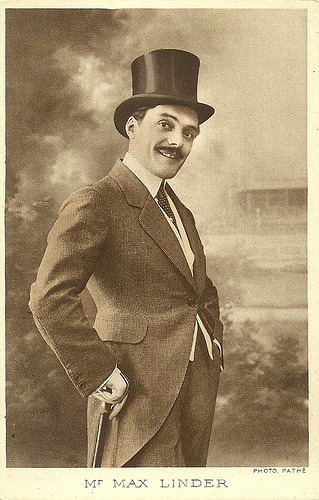
French postcard. Photo: Pathé.
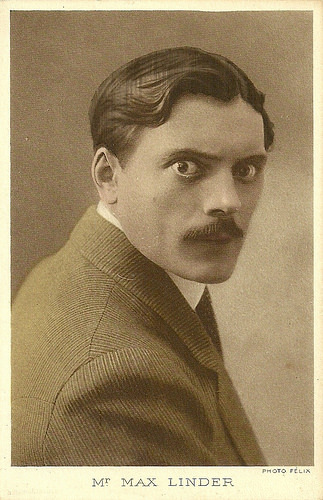
French postcard by Pathé Frères. Photo: Felix.
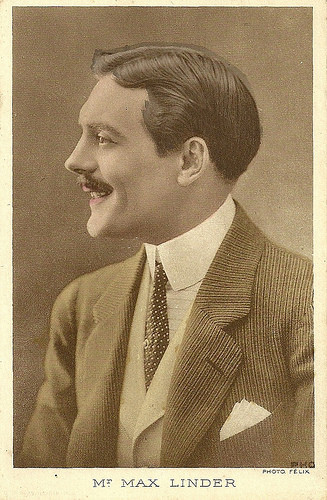
French postcard by Pathé Frères. Photo: Felix.
America
While in the hospital in 1916, Max Linder was visited by H.A. Spoor, a nephew of the president of Essanay films, G.K. Spoor. Having lost Charlie Chaplin, Spoor wanted Linder to "take his place" and offered him $5,000 per week to write, direct, and star in 12 three-reel comedies to be made in the studio's Chicago location.
Linder went to the US, but his first few American-made Max films didn't make the same impression as the Chaplin shorts. Recurring ill-health meant that his US films had little of the sparkle of his early French work. After only three films were completed Linder headed back to France.
For the convalescence of his pleurisy, Linder went to the lake of Geneva. In 1919 it seemed like Max was his old self again and his screen version of Le petit café/The Little Café (Raymond Bernard, 1919) was received enthusiastically by critics and audiences on both sides of the Atlantic.
He made another attempt at filmmaking in the US for the recently-formed United Artists (one of whose founders was Charles Chaplin ). He worked as a film producer, screenwriter, director, and leading actor on three films: Seven Years Bad Luck (Max Linder, 1921), Be My Wife (Max Linder, 1921), and the film he considered his best, the inventive parody The Three Must-Get-Theres (Max Linder, 1922).
Endowed with overflowing imagination, he filled his films with an inexhaustible variety of gags. For example, Max was the first filmmaker to use the genius mirror gag in Seven Years Bad Luck, which the Marx Brothers used again so memorably in their film Duck Soup (Leo McCarey, 1933).
However, the work exhausted Max, and after finishing the last film he left the United States once again. Back in France, he appeared in only two more films. In Au Secours!/Help! (Abel Gance, 1923) he played a tragic part.
His last film, Der Zirkuskönig/King of the Circus (Max Linder, Édouard-Émile Violet, 1924) with Vilma Bánky , was made in Vienna, Austria. For the film Chevalier Barkas/The Knight Barkas he contacted the then-unknown director René Clair. But the film would never be realised.
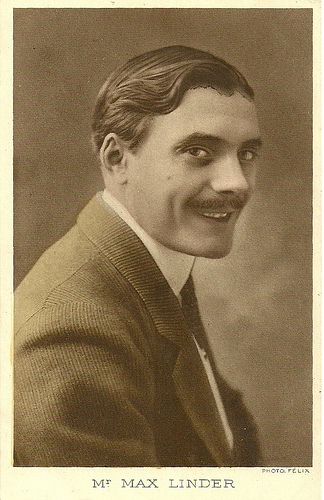
French postcard by Pathé Frères. Photo: Felix.
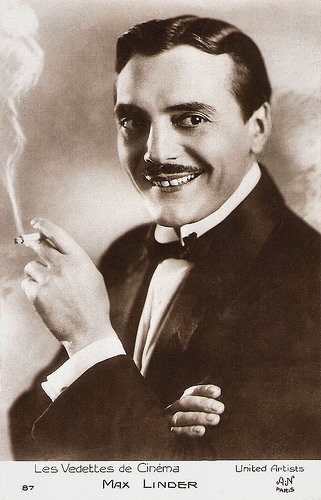
French postcard by A.N, Paris in the Les Vedettes de Cinéma series, no. 87. Photo: United Artists.
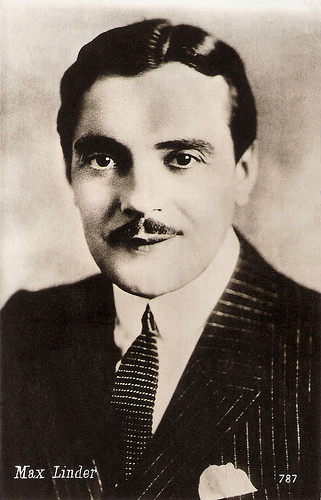
Italian postcard by Casa Editrice Ballerini & Fratini, Firenze, no. 787.
Suicide pact
The after-effect of Max Linder's war service was that he suffered from continuing health problems including bouts of severe depression.
In 1923, he married the 18-years old Hélène Peters, with whom he had a daughter, Maud. In the same year, he sold his Max Linder cinema.
The emotional problems besetting Linder evidenced themselves when he and his wife made a suicide pact. In early 1924 they attempted suicide at a hotel in Vienna, Austria. They were found and were recuperated, but on 31 October 1925 Linder and his wife were successful in taking their lives in Paris.
After Linder's death, Chaplin dedicated one of his films: "For the unique Max, the great master - his student Charles Chaplin ". But in the ensuing years, Max Linder was relegated to little more than a footnote in film history.
In 1963, a compilation film titled En compagnie de Max Linder/Laugh with Max Linder was released. Later his daughter made a documentary film titled L'homme au chapeau de soie/The Man in the Silk Hat (Maud Linder, 1983). Max Linder's comic gestures, planned expressions, anachronisms, contrasts, and use of the unexpected, as well as his comic chase scenes (pursuits), became again the inspiration for young comedians.
Max Linder appeared in more than 400 films, mostly short comedies. Only about 80 survive. His daughter and the keeper of his heritage, Maud Linder, passed away on 25 October 2017).
Clip with Max Linder and Maurice Tourneur in Champion de boxe/Boxing Champion (1910). Source: TheBzzz (YouTube).
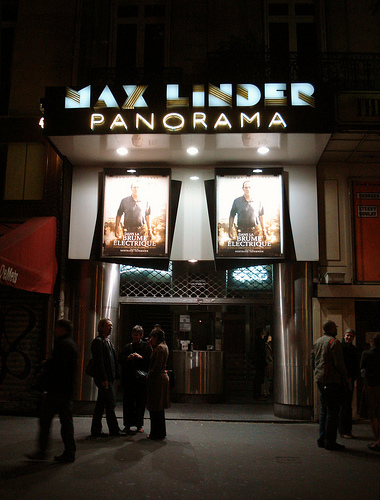
A May 2009 photo of the Max Linder cinema in Paris.
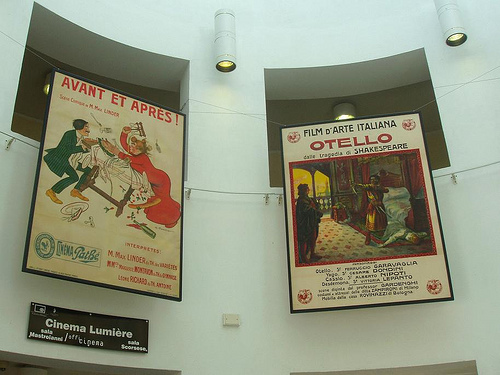
Left a poster for the Max Linder comedy Avant et après/Before and After, exhibited at the Cinema Ritrovato festival 2009. Atrium of the Lumiere cinema, Bologna, Italy.
Sources: Lisa Stein Haven (The Rise & Fall of Max Linder), Thomas Staedeli (Cyranos), (IMDb), Wikipedia, Golden Silents, and .

French postcard by Helio Paul et Vigier, Paris. Publicity card for the Pathé-Baby projector.

German postcard by Verlag Herm. Leiser, no. 9977. Photo: Gerlach.

French postcard by Pathé Frères. Photo: Felix.
Gentleman Max
Max Linder was born Gabriel-Maximilien Leuvielle in Saint-Loubès, France in 1883 to a Jewish wine-growing family.
He grew up with a passion for the stage and at 17 he dropped out of school in order to join a touring theatre troupe, which did not please his parents.
While working in Paris as an actor in the theatre and vaudeville, Leuvielle became fascinated with motion pictures. In 1905 he took a job with Pathé Frères and in the following years, he became a comedic actor, director, screenwriter, as well as a producer under the stage name, Max Linder.
His debut was Première sortie/His First Night Out (Louis J. Gasnier, 1905). He created what was probably the first identifiable film character: ‘Max’, an elegant, joyful, romantic, top-hatted dandy.
Max appeared for the first time in Debuts d'un patineur/The Unskillful Skater (Louis J. Gasnier, 1907) and would return in successive situation comedies. ‘Gentleman Max’ was frequently in hot water because of his penchant for beautiful women and the good life.

French postcard for La légende de Polichinelle (Albert Capellani, Pathé frères 1907). With Max Linder as Polichinelle. Théâtre Pathé Grolée, Lyon. Polichinelle is an automaton in love with a cute doll in the same shop. When the doll is sold, a fairy helps Polichinelle following her and after a series of wild adventures he arrives at the house of the buyer just in time to save the doll from being burned.

French postcard by Cinémagazine, no. 24.

French postcard by Cinémagazine, no. 188.

French postcard by Edition Pathé Frères.
Comedy Star No. 1
After comedian André Deed went to Italy, Max Linder moved up and became the comedy star no. 1 for Pathé.
In 1910 he shot one comedy each week. By 1911, Linder was directing all his own films as well as writing the script and the universality of silent films brought Linder fame and fortune throughout Europe. By 1912, he was the highest-paid film star in the world, with an unprecedented salary of one million francs.
His success didn't have any limits: whether Spain, Germany, Italy, or Russia, Max Linder was everywhere welcomed with enthusiasm during his live entrances in the capital cities. In Russia, the police had to call the Army for help so that Linder was able to leave the Moscow railroad station.
One of the best and more successful examples of his type of humour is the one-reeler Max et l'inauguration de la Statue/The Living Statue (Max Linder, 1912). Max attends a costume ball, dressed in a suit of armour. After drinking too much at the party, he passes out on the sidewalk. Meanwhile, during the evening, a new suit of armour to be unveiled at the Louvre the next day is stolen by a pair of thieves. The police, discovering the theft, stumbles upon Max. They take him back to the Louvre where he is unveiled for the Museum committee. They depart, whereupon the thieves return, take Max, and, back in the hideout, attempt to open the armour with tools. Max awakens, scares the burglars, then, in the final frame, strolls away, strumming a guitar.
The weekly adventures of Max were impatiently awaited by faithful and enthusiastic audiences. In 1914 Linder decided to realise one of his old dreams: to start a cinema. He bought a cinema in Paris with 1,200 seats, created in 1912, the Kosmorama. The Ciné Max Linder opened in December 1914.
World War I brought a temporary end to Linder's career in film. Physically unfit for combat duty, he worked as a dispatch driver during the war until he was seriously wounded. He was gassed, and the illness that resulted would blight his career.

French postcard. Photo: Pathé.

French postcard by Pathé Frères. Photo: Felix.

French postcard by Pathé Frères. Photo: Felix.
America
While in the hospital in 1916, Max Linder was visited by H.A. Spoor, a nephew of the president of Essanay films, G.K. Spoor. Having lost Charlie Chaplin, Spoor wanted Linder to "take his place" and offered him $5,000 per week to write, direct, and star in 12 three-reel comedies to be made in the studio's Chicago location.
Linder went to the US, but his first few American-made Max films didn't make the same impression as the Chaplin shorts. Recurring ill-health meant that his US films had little of the sparkle of his early French work. After only three films were completed Linder headed back to France.
For the convalescence of his pleurisy, Linder went to the lake of Geneva. In 1919 it seemed like Max was his old self again and his screen version of Le petit café/The Little Café (Raymond Bernard, 1919) was received enthusiastically by critics and audiences on both sides of the Atlantic.
He made another attempt at filmmaking in the US for the recently-formed United Artists (one of whose founders was Charles Chaplin ). He worked as a film producer, screenwriter, director, and leading actor on three films: Seven Years Bad Luck (Max Linder, 1921), Be My Wife (Max Linder, 1921), and the film he considered his best, the inventive parody The Three Must-Get-Theres (Max Linder, 1922).
Endowed with overflowing imagination, he filled his films with an inexhaustible variety of gags. For example, Max was the first filmmaker to use the genius mirror gag in Seven Years Bad Luck, which the Marx Brothers used again so memorably in their film Duck Soup (Leo McCarey, 1933).
However, the work exhausted Max, and after finishing the last film he left the United States once again. Back in France, he appeared in only two more films. In Au Secours!/Help! (Abel Gance, 1923) he played a tragic part.
His last film, Der Zirkuskönig/King of the Circus (Max Linder, Édouard-Émile Violet, 1924) with Vilma Bánky , was made in Vienna, Austria. For the film Chevalier Barkas/The Knight Barkas he contacted the then-unknown director René Clair. But the film would never be realised.

French postcard by Pathé Frères. Photo: Felix.

French postcard by A.N, Paris in the Les Vedettes de Cinéma series, no. 87. Photo: United Artists.

Italian postcard by Casa Editrice Ballerini & Fratini, Firenze, no. 787.
Suicide pact
The after-effect of Max Linder's war service was that he suffered from continuing health problems including bouts of severe depression.
In 1923, he married the 18-years old Hélène Peters, with whom he had a daughter, Maud. In the same year, he sold his Max Linder cinema.
The emotional problems besetting Linder evidenced themselves when he and his wife made a suicide pact. In early 1924 they attempted suicide at a hotel in Vienna, Austria. They were found and were recuperated, but on 31 October 1925 Linder and his wife were successful in taking their lives in Paris.
After Linder's death, Chaplin dedicated one of his films: "For the unique Max, the great master - his student Charles Chaplin ". But in the ensuing years, Max Linder was relegated to little more than a footnote in film history.
In 1963, a compilation film titled En compagnie de Max Linder/Laugh with Max Linder was released. Later his daughter made a documentary film titled L'homme au chapeau de soie/The Man in the Silk Hat (Maud Linder, 1983). Max Linder's comic gestures, planned expressions, anachronisms, contrasts, and use of the unexpected, as well as his comic chase scenes (pursuits), became again the inspiration for young comedians.
Max Linder appeared in more than 400 films, mostly short comedies. Only about 80 survive. His daughter and the keeper of his heritage, Maud Linder, passed away on 25 October 2017).
Clip with Max Linder and Maurice Tourneur in Champion de boxe/Boxing Champion (1910). Source: TheBzzz (YouTube).

A May 2009 photo of the Max Linder cinema in Paris.

Left a poster for the Max Linder comedy Avant et après/Before and After, exhibited at the Cinema Ritrovato festival 2009. Atrium of the Lumiere cinema, Bologna, Italy.
Sources: Lisa Stein Haven (The Rise & Fall of Max Linder), Thomas Staedeli (Cyranos), (IMDb), Wikipedia, Golden Silents, and .
Published on October 04, 2021 22:00
October 3, 2021
Marlene Dietrich's German films
Recognising the crucial role of women in the history of cinema is a true leitmotif of this edition of Le Giornate del Cinema Muto, the 6th under Jay Weissberg’s direction. This year’s biggest retrospective is dedicated to the Austrian-Jewish actress and producer Ellen Richter. The festival is also launching a two-year series dedicated to American women screenwriters, including Anita Loos, Beulah Marie Dix, and Dorothy Yost. And the Nasty Women return, those rule-busting, anarchic female comedians who refuse to be confined by notions of propriety and gender roles. In Der Juxbaron/The Imaginary Baron (1927), a charming feature Ellen Richter produced, the young Marlene Dietrich featured in a key early role. Before Marlene Dietrich (1901-1992) became the first German actress who was successful in Hollywood, she made 19 silent films in Germany and Austria until her first German sound film made her an international star.
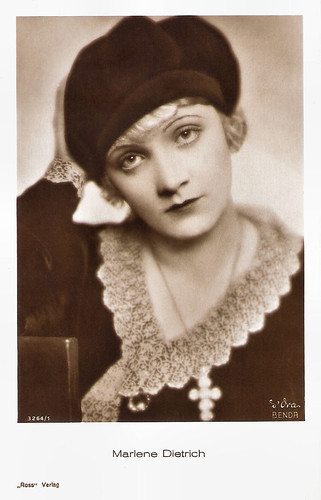
German postcard by Ross Verlag, no. 3264/1, 1928-1929. Photo: D'Ora (Dora Kallmus), Arthur Benda.
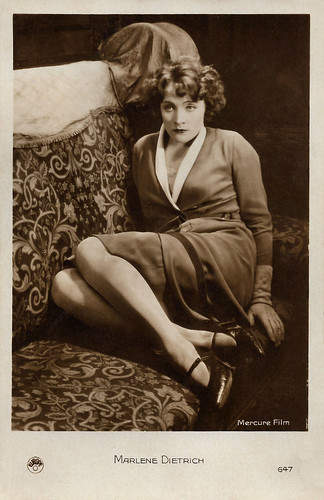
French postcard by Europe, no. 647. Photo: Mercure Film. Marlene Dietrich in Die Frau, nach der man sich sehnt/The Woman One Longs For (Kurt Bernhardt, 1929).
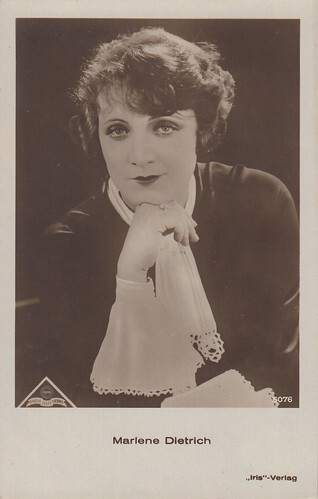
Austrian postcard by Iris Verlag, no. 5076. Photo: Sascha Film. Marlene Dietrich in Café Elektric/Cafe Electric (Gustav Ucicky, 1927). Collection: Marlene Pilaete.
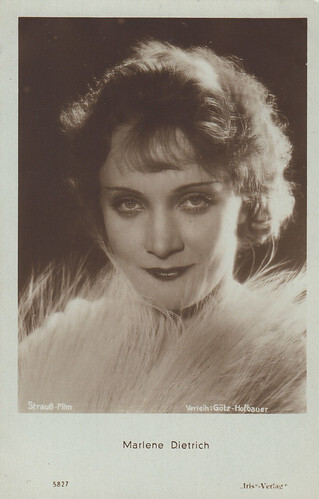
Austrian postcard by Iris-Verlag, no. 5827. Photo: Strauss-Film. Marlene Dietrich in Gefahren der Brautzeit/Nights of Love (Fred Sauer, 1929). Collection: Marlene Pilaete.
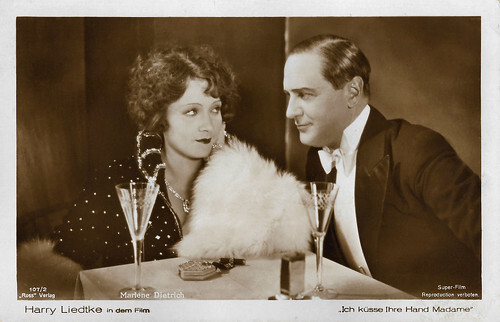
German postcard by Ross Verlag, Berlin, no. 107/2. Photo: Super-Film. Harry Liedtke and Marlene Dietrich in Ich küsse Ihre Hand Madame/I Kiss Your Hand Madame (Robert Land, 1929).
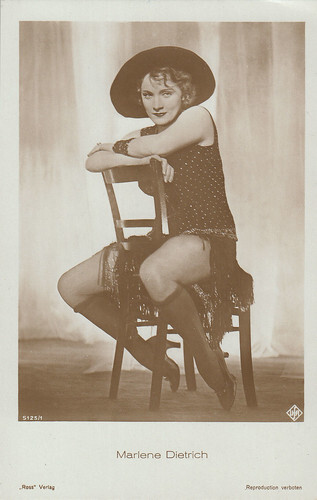
German postcard by Ross Verlag, no. 5125/1, 1930-1931. Photo: Ufa. Marlene Dietrich in Der blaue Engel/The Blue Angel (Josef von Sternberg, 1930). Collection: Marlene Pilaete.
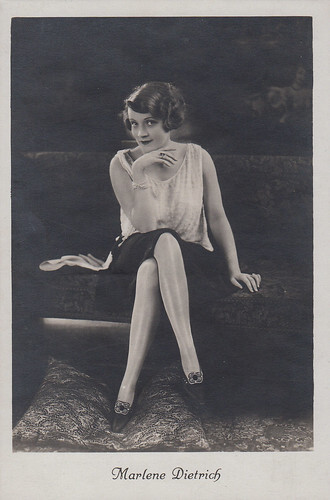
German postcard by H.C. Stöckel, Hannover-Linden for Bemberg socks. Caption: "I only wear Bemberg socks. Marlene Dietrich ". Collection: Marlene Pilaete.
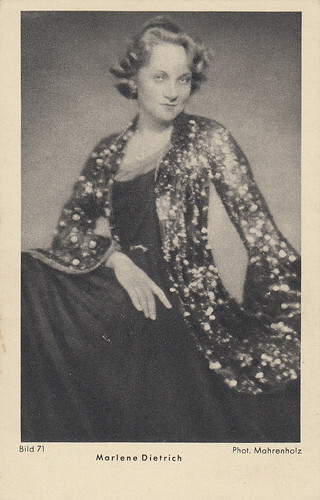
German postcard by Eidelsan, serie 1 , Bild 71. Photo: Mahrenholz. Collection: Marlene Pilaete.
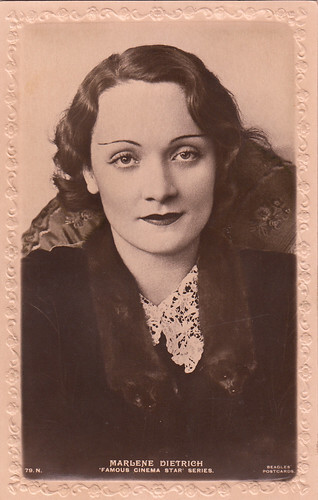
British postcard in the Famous Cinema Star Series by Beagles Postcards, no. 79 N. Collection: Marlène Pilaete.
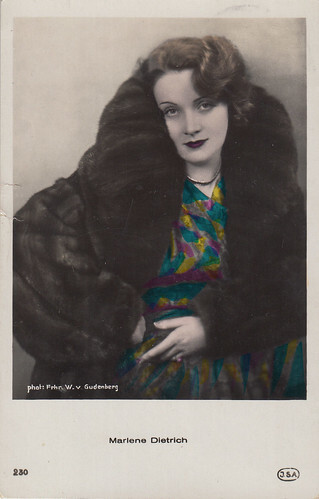
Dutch postcard by JSA, no. 230. Photo: Frhr. W. von Gudenberg. Collection: Marlene Pilaete.
The woman one longs for
Throughout her long career, Marlene Dietrich constantly re-invented herself. In 1921, she auditioned unsuccessfully for Max Reinhardt's drama academy, but she soon found herself working in his theatres as a chorus girl and playing small roles in dramas.
The next year she played a part in the silent film So sind die Männer/The Little Napoleon (Georg Jacoby, 1922). On the set of another film, Tragödie der Liebe/The Tragedy of Love (Joe May, 1923), she met production assistant Rudolf Sieber. They were married in 1923. Her only child, daughter Maria Elisabeth Sieber, later billed as actress Maria Riva, was born in 1924.
Throughout the 1920s Marlene continued to work on stage and in films both in Berlin and Vienna. She attracted the most attention in stage musicals and revues, such as 'Broadway' and 'Es Liegt in der Luft' (It's in the Air).
By the late 1920s, she was also playing leading parts in such films as Café Elektric/Cafe Electric (Gustav Ucicky, 1927) with Willi Forst , Ich küsse Ihre Hand, Madame/I Kiss Your Hand Madame (Robert Land, 1929) with Harry Liedtke , and Die Frau, nach der man sich sehnt/The Woman One Longs For (Kurt/Curtis Bernhardt, 1929) opposite Fritz Kortner .
In 1929 Marlene Dietrich played her breakthrough role of Lola-Lola, a cabaret singer who causes the downfall of Immanuel Rath ( Emil Jannings ), a hitherto respected schoolmaster, in the Ufa production Der blaue Engel/The Blue Angel (Josef von Sternberg, 1930), of which separate German and English versions were shot simultaneously.
Josef von Sternberg thereafter took credit for having ‘discovered’ her. The film is also noteworthy for introducing her signature song 'Falling in Love Again'. On the strength of Der blaue Engel's success, and with encouragement and promotion from Von Sternberg, Dietrich then moved to Hollywood.

German collectors card by Ross Verlag in the series 'Vom Werden deutscher Filmkunst - Der Tonfilm', album no. 11, picture no. 9, group 45. Photo: Ufa. Marlene Dietrich and Rosa Valetti (middle) in Der blaue Engel/The Blue Angel (Josef von Sternberg, 1930). Caption: Marlene Dietrich as classy chansonette Lola in the 'Blue Angel'.
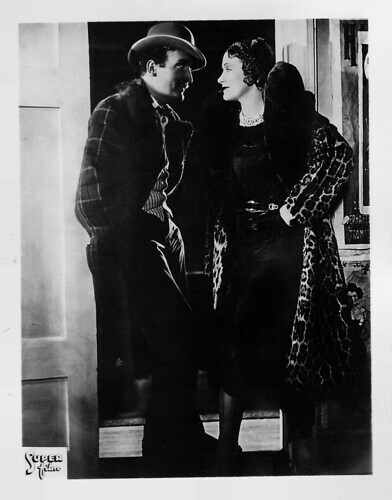
German collectors card. Photo: Super film. Hans Albers and Marlene Dietrich in Der blaue Engel/The Blue Angel (Josef von Sternberg, 1930).
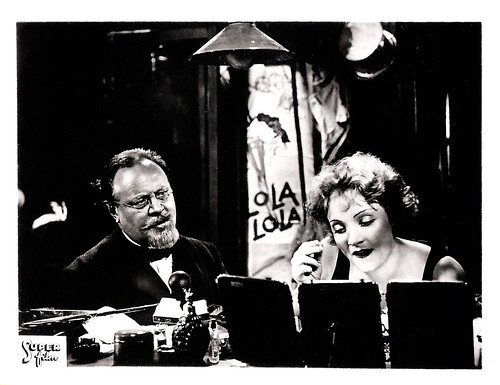
German collectors card. Photo: Super film. Emil Jannings and Marlene Dietrich in Der blaue Engel/The Blue Angel (Josef von Sternberg, 1930).
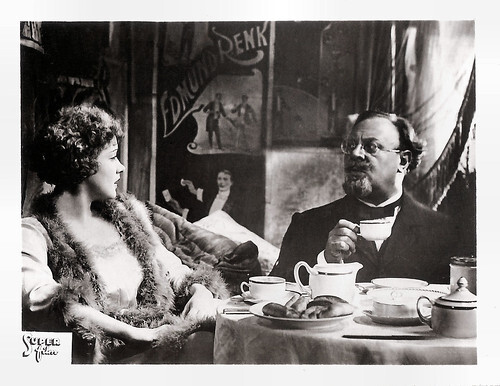
German collectors card. Photo: Super film. Emil Jannings and Marlene Dietrich in Der blaue Engel/The Blue Angel (Josef von Sternberg, 1930).
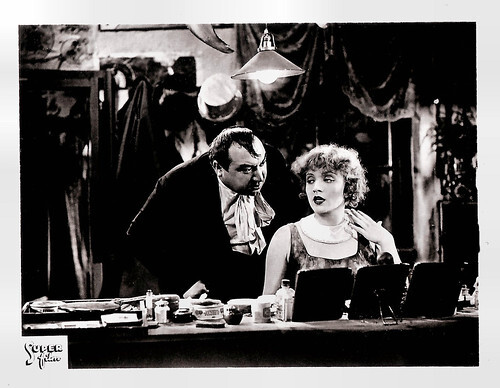
German collectors card. Photo: Super film. Kurt Gerron and Marlene Dietrich in Der blaue Engel/The Blue Angel (Josef von Sternberg, 1930).
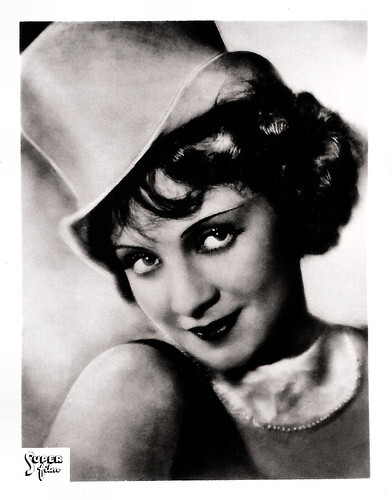
German collectors card. Photo: Super film. Publicity still for Der blaue Engel/The Blue Angel (Josef von Sternberg, 1930).
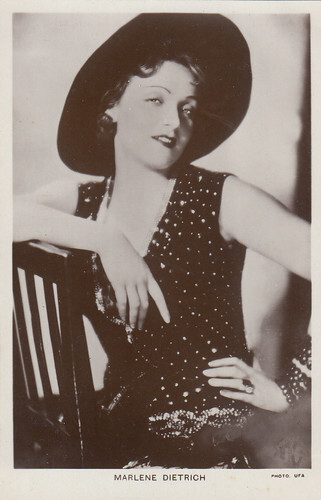
British postcard in the Picturegoer series. Photo: Ufa. Marlene Dietrich in Der blaue Engel/The Blue Angel (Josef von Sternberg, 1930). Collection: Marlene Pilaete.
Sources: Wikipedia and .

German postcard by Ross Verlag, no. 3264/1, 1928-1929. Photo: D'Ora (Dora Kallmus), Arthur Benda.

French postcard by Europe, no. 647. Photo: Mercure Film. Marlene Dietrich in Die Frau, nach der man sich sehnt/The Woman One Longs For (Kurt Bernhardt, 1929).

Austrian postcard by Iris Verlag, no. 5076. Photo: Sascha Film. Marlene Dietrich in Café Elektric/Cafe Electric (Gustav Ucicky, 1927). Collection: Marlene Pilaete.

Austrian postcard by Iris-Verlag, no. 5827. Photo: Strauss-Film. Marlene Dietrich in Gefahren der Brautzeit/Nights of Love (Fred Sauer, 1929). Collection: Marlene Pilaete.

German postcard by Ross Verlag, Berlin, no. 107/2. Photo: Super-Film. Harry Liedtke and Marlene Dietrich in Ich küsse Ihre Hand Madame/I Kiss Your Hand Madame (Robert Land, 1929).

German postcard by Ross Verlag, no. 5125/1, 1930-1931. Photo: Ufa. Marlene Dietrich in Der blaue Engel/The Blue Angel (Josef von Sternberg, 1930). Collection: Marlene Pilaete.

German postcard by H.C. Stöckel, Hannover-Linden for Bemberg socks. Caption: "I only wear Bemberg socks. Marlene Dietrich ". Collection: Marlene Pilaete.

German postcard by Eidelsan, serie 1 , Bild 71. Photo: Mahrenholz. Collection: Marlene Pilaete.

British postcard in the Famous Cinema Star Series by Beagles Postcards, no. 79 N. Collection: Marlène Pilaete.

Dutch postcard by JSA, no. 230. Photo: Frhr. W. von Gudenberg. Collection: Marlene Pilaete.
The woman one longs for
Throughout her long career, Marlene Dietrich constantly re-invented herself. In 1921, she auditioned unsuccessfully for Max Reinhardt's drama academy, but she soon found herself working in his theatres as a chorus girl and playing small roles in dramas.
The next year she played a part in the silent film So sind die Männer/The Little Napoleon (Georg Jacoby, 1922). On the set of another film, Tragödie der Liebe/The Tragedy of Love (Joe May, 1923), she met production assistant Rudolf Sieber. They were married in 1923. Her only child, daughter Maria Elisabeth Sieber, later billed as actress Maria Riva, was born in 1924.
Throughout the 1920s Marlene continued to work on stage and in films both in Berlin and Vienna. She attracted the most attention in stage musicals and revues, such as 'Broadway' and 'Es Liegt in der Luft' (It's in the Air).
By the late 1920s, she was also playing leading parts in such films as Café Elektric/Cafe Electric (Gustav Ucicky, 1927) with Willi Forst , Ich küsse Ihre Hand, Madame/I Kiss Your Hand Madame (Robert Land, 1929) with Harry Liedtke , and Die Frau, nach der man sich sehnt/The Woman One Longs For (Kurt/Curtis Bernhardt, 1929) opposite Fritz Kortner .
In 1929 Marlene Dietrich played her breakthrough role of Lola-Lola, a cabaret singer who causes the downfall of Immanuel Rath ( Emil Jannings ), a hitherto respected schoolmaster, in the Ufa production Der blaue Engel/The Blue Angel (Josef von Sternberg, 1930), of which separate German and English versions were shot simultaneously.
Josef von Sternberg thereafter took credit for having ‘discovered’ her. The film is also noteworthy for introducing her signature song 'Falling in Love Again'. On the strength of Der blaue Engel's success, and with encouragement and promotion from Von Sternberg, Dietrich then moved to Hollywood.

German collectors card by Ross Verlag in the series 'Vom Werden deutscher Filmkunst - Der Tonfilm', album no. 11, picture no. 9, group 45. Photo: Ufa. Marlene Dietrich and Rosa Valetti (middle) in Der blaue Engel/The Blue Angel (Josef von Sternberg, 1930). Caption: Marlene Dietrich as classy chansonette Lola in the 'Blue Angel'.

German collectors card. Photo: Super film. Hans Albers and Marlene Dietrich in Der blaue Engel/The Blue Angel (Josef von Sternberg, 1930).

German collectors card. Photo: Super film. Emil Jannings and Marlene Dietrich in Der blaue Engel/The Blue Angel (Josef von Sternberg, 1930).

German collectors card. Photo: Super film. Emil Jannings and Marlene Dietrich in Der blaue Engel/The Blue Angel (Josef von Sternberg, 1930).

German collectors card. Photo: Super film. Kurt Gerron and Marlene Dietrich in Der blaue Engel/The Blue Angel (Josef von Sternberg, 1930).

German collectors card. Photo: Super film. Publicity still for Der blaue Engel/The Blue Angel (Josef von Sternberg, 1930).

British postcard in the Picturegoer series. Photo: Ufa. Marlene Dietrich in Der blaue Engel/The Blue Angel (Josef von Sternberg, 1930). Collection: Marlene Pilaete.
Sources: Wikipedia and .
Published on October 03, 2021 22:00
October 2, 2021
The stars of Lady Windermere's Fan (1925)
Le Giornate del Cinema Muto, the international silent film festival of Pordenone, opened yesterday officially with Ernst Lubitsch's wonderful Lady Windermere's Fan, based on Oscar Wilde's 1892 play. There was a new restoration from MoMA, featuring an intimate score by Carl Davis. In this post, we focus on two of the stars of the film. Not on May McAvoy and Ronald Colman, because we did recent posts on them, but we present the less-known Irene Rich and Bert Lytell.
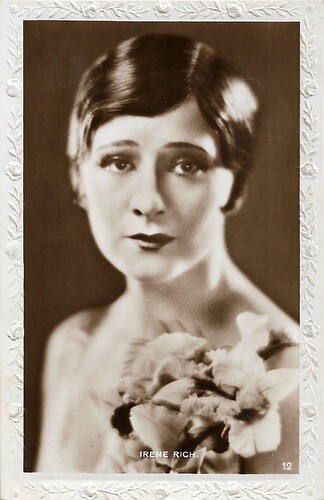
British Real photograph postcard, no. 82. Irene Rich.
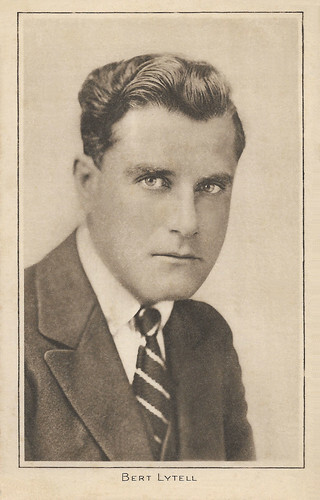
British postcard in the Pictures Portrait Gallery Series, London, no. 171. Bert Lytell.
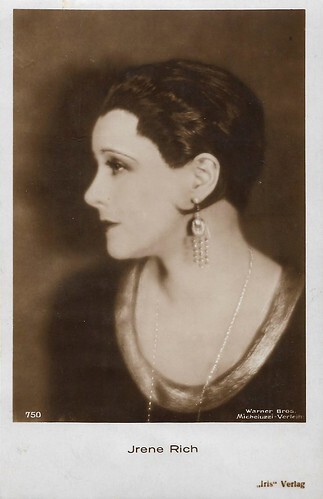
Austrian postcard by Iris Verlag, no. 750. Photo: Warner Bros. / Micheluzzi-Verleih. Irene Rich.

American Arcade card. Bert Lytell.
Irene Rich
American actress Irene Rich was born Irene Luther in Buffalo, New York, in 1891. At a young age, she moved from New York to California with her parents.
After her schooling, she first began working as a real estate agent and initially aspired to a middle-class life. She married twice in that period, divorced just as many times, and became the mother of two daughters, Frances and Jane. Frances Rich (1910-2007) also became an actress in the 1930s and later worked as a sculptor. Despite her divorce, she kept the last name Rich as her actor's name.
Her career as an actress began in 1918, as an extra in Jerome Storm's silent film A Desert Wooing. She landed a major role in her next film, The Girl in His House (Thomas R. Mills, 1919). Irene Rich was a sought-after character actress in the silent era, appearing in 10 feature films in 1922 alone. Rich worked for Will Rogers, who used her in eight pictures, including Water Water Everywhere (1920), The Strange Boarder (1920), Jes' Call Me Jim (1920), Boys Will Be Boys (1921), and The Ropin' Fool (1921).
She often portrayed society women, such as the Queen in Ernst Lubitsch 's Rosita (1923) starring Mary Pickford , the Duchess of York in Beau Brummel (Harry Beaumont, 1924) starring John Barrymore, and Mrs Erlynne in Lubitsch's Lady Windermere's Fan (Ernst Lubitsch, 1925), starring May McAvoy and Ronald Colman .
She was also able to survive the switch to talkies in the late 1920s without much difficulty, e.g. playing Jackie Cooper 's mother Linda in The Champ (King Vidor, 1931). After a career gap in the mid-1930s, she returned towards the end of the decade, again playing mothers such as Deanna Durbin's mother in That Certain Age (Edward Ludwig, 1938), and John Agar's mother and Shirley Temple 's future mother-in-law in Fort Apache (John Ford, 1948), her penultimate film. Rich continued her screen career until 1948, appearing in a total of 112 American films.
In 1933, Irene Rich began 'The Irene Rich Show', one of the most successful radio programmes of the time, which was heard throughout the United States for over a decade, until 1944. In the theatre, she appeared twice on Broadway, in a play in 1935, then in a successful musical from 1948 to 1950.
At the end of the 1940s, she met her future fourth husband, the businessman George Henry Clifford, whom she married in 1950. Because of the prosperity, he could now offer her, she withdrew from acting into private life from then on. Not much is known about Rich's later life. In 1988, Irene Rich died in Hope Ranch, a suburb of Santa Barbara, at the age of 96. As a result of her two careers in film and radio, Irene Rich has two stars dedicated to her on the Hollywood Boulevard Walk of Fame, one for her radio work and the other for her contribution to film.
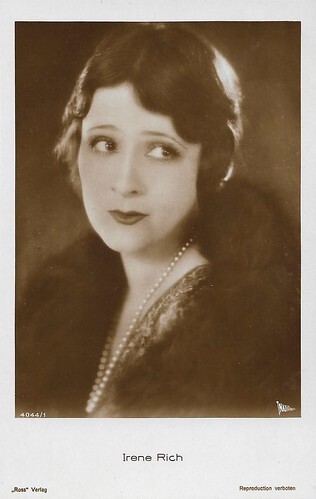
German postcard by Ross Verlag, no. 4044/1, 1929-1930. Photo: National.
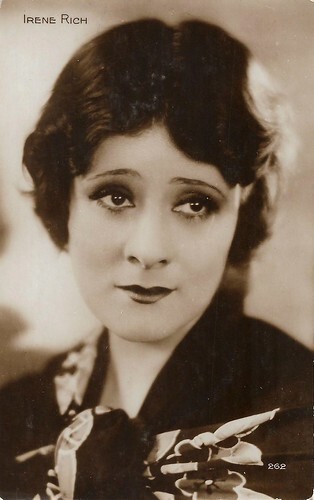
French postcard by Cinémagazine-Edition, no. 262.
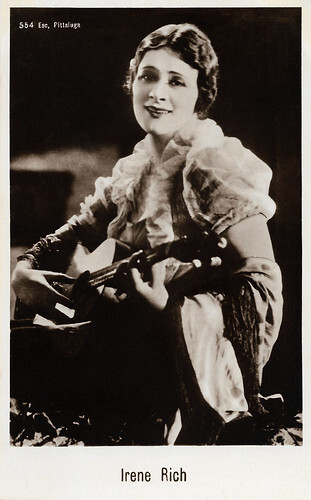
Italian postcard by G.B. Falci, Editore, Milano, no. 554. Photo: Esc. Pittaluga.
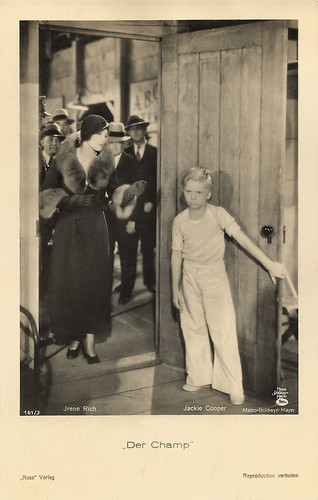
German postcard by Ross Verlag, no. 161/3. Photo: Metro-Goldwyn-Mayer Jackie Cooper and Irene Rich in The Champ (King Vidor, 1931).
Bert Lytell
American actor, producer (film and stage), director and screenwriter Bertram 'Bert' Lytell was born in 1885 in New York City, New York. Lytell was the son of actor, author, and producer William H. Lytell and Blanche Mortimer. His mother was an actress before she married, and her father and grandfather were actors.
Lytell left Upper Canada College at age 16 to become an actor. His stage acting debut came with the Columbia Stock Company in Newark, New Jersey when he was 17 years old. He went on to appear with stock theatre companies in Boston, Honolulu, Los Angeles, New Orleans, and Rochester, in addition to heading his own stock troupes in Albany, New York, and San Francisco. He appeared with Marie Dressler in her 1914 Broadway play, 'A Mix-Up'. He also performed in vaudeville in the 1920s with the one-act play 'The Valiant'.
In cinema, Bert Lytell was most active during the silent era, appearing in forty-nine American films released between 1917 and 1927. In 1917, Lytell made his film debut starring as Michael Lanyard in The Lone Wolf. He subsequently made four Lone Wolf sequels, ending with The Last of the Lone Wolf (1930). He also starred as Boston Blackie in Boston Blackie's Little Pal (1918) and Blackie's Redemption (1919).
His female partners included Betty Compson in two films including A King's Favourite (George Fitzmaurice, 1922), Alice Lake (three films), Barbara La Marr (two films), May McAvoy in Ernst Lubitsch 's A King's Favourite (1925) and Lady Windermere's Fan (1925), Irene Rich (two films in 1925), Rosemary Theby (five films), Virginia Valli (four films), Lois Wilson (two films), and Claire Windsor (three films), the latter being his first wife.
After the silent period, Lytell played the lead in only five talkies. The first was On Trial (Archie Mayo, 1928), with Pauline Frederick , and the last was The Single Sin (William Nigh, 1931), with Kay Johnson. He also made two cameos, first in the short film The Stolen Jewels (William C. McGann, 1931), with Wallace Beery and Buster Keaton, and finally in Frank Borzage's Cabaret of the Stars (1943).
After his retirement from the silver screen, Bert Lytell continued his acting career in the theatre. In particular, he played until 1946 on Broadway, where he had started in 1914. On the New York stage, he acted alongside Kirk Douglas , Ruth Gordon, Otto Preminger and Margaret Sullavan. He also took part in the creation of the musical 'Lady in the Dark' in 1941, with music by Kurt Weill and with Gertrude Lawrence in the title role. He also appeared on television from 1948 to 1953 in six series, including an episode in Tales of Tomorrow (1951).
Besides acting, Bert Lytell was a director (Along Came Love in 1936, with Charles Starrett and H. B. Warner), producer (a play on Broadway in 1934-1935 and a film in 1936) and screenwriter (two silent films in 1918).
Bert Lytell died in 1954 in New York. For his contribution to film, he has a star on the Hollywood Boulevard Walk of Fame. Lytell married the silent film actress Claire Windsor in 1925; they divorced in 1927. His younger brother Wilfred Lytell (1891–1954) also became a stage and screen actor.
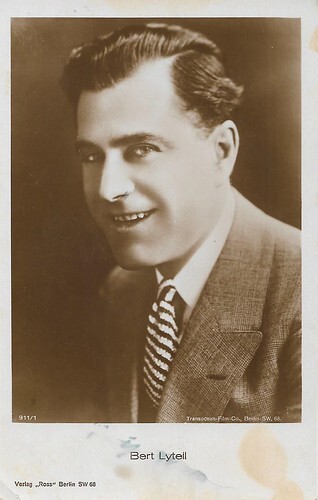
German postcard by Ross Verlag, no. 911/1, 1925-1926. Photo: Transocean-Film-Co., Berlin.
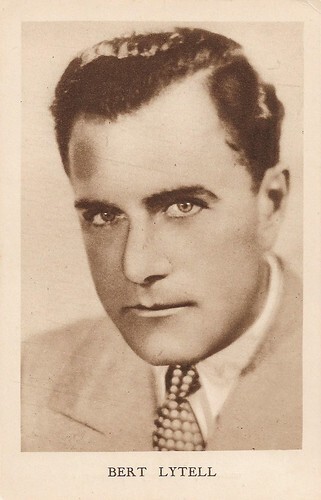
Belgian postcard by Ed. Weekblad Cinema, Antwerp.
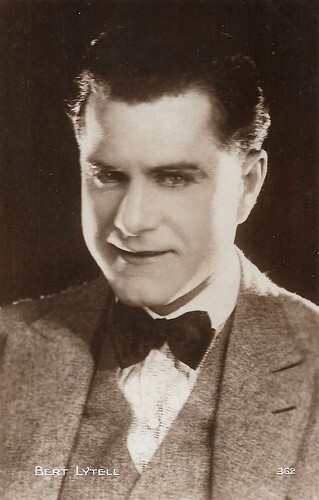
French postcard by Cinémagazine-Edition, no. 362.
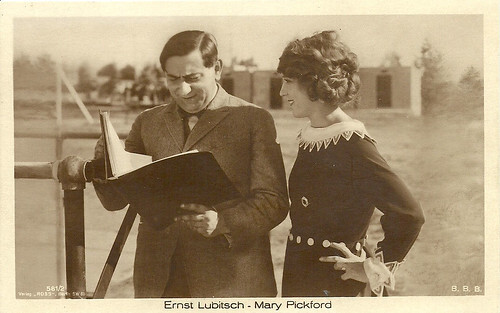
German postcard by Ross Verlag, no. 581/2, 1919-1924. Photo: B.B.B. Collection: Didier Hanson. Ernst Lubitsch and Mary Pickford .
Sources: Wikipedia (English, German and French) and .

British Real photograph postcard, no. 82. Irene Rich.

British postcard in the Pictures Portrait Gallery Series, London, no. 171. Bert Lytell.

Austrian postcard by Iris Verlag, no. 750. Photo: Warner Bros. / Micheluzzi-Verleih. Irene Rich.

American Arcade card. Bert Lytell.
Irene Rich
American actress Irene Rich was born Irene Luther in Buffalo, New York, in 1891. At a young age, she moved from New York to California with her parents.
After her schooling, she first began working as a real estate agent and initially aspired to a middle-class life. She married twice in that period, divorced just as many times, and became the mother of two daughters, Frances and Jane. Frances Rich (1910-2007) also became an actress in the 1930s and later worked as a sculptor. Despite her divorce, she kept the last name Rich as her actor's name.
Her career as an actress began in 1918, as an extra in Jerome Storm's silent film A Desert Wooing. She landed a major role in her next film, The Girl in His House (Thomas R. Mills, 1919). Irene Rich was a sought-after character actress in the silent era, appearing in 10 feature films in 1922 alone. Rich worked for Will Rogers, who used her in eight pictures, including Water Water Everywhere (1920), The Strange Boarder (1920), Jes' Call Me Jim (1920), Boys Will Be Boys (1921), and The Ropin' Fool (1921).
She often portrayed society women, such as the Queen in Ernst Lubitsch 's Rosita (1923) starring Mary Pickford , the Duchess of York in Beau Brummel (Harry Beaumont, 1924) starring John Barrymore, and Mrs Erlynne in Lubitsch's Lady Windermere's Fan (Ernst Lubitsch, 1925), starring May McAvoy and Ronald Colman .
She was also able to survive the switch to talkies in the late 1920s without much difficulty, e.g. playing Jackie Cooper 's mother Linda in The Champ (King Vidor, 1931). After a career gap in the mid-1930s, she returned towards the end of the decade, again playing mothers such as Deanna Durbin's mother in That Certain Age (Edward Ludwig, 1938), and John Agar's mother and Shirley Temple 's future mother-in-law in Fort Apache (John Ford, 1948), her penultimate film. Rich continued her screen career until 1948, appearing in a total of 112 American films.
In 1933, Irene Rich began 'The Irene Rich Show', one of the most successful radio programmes of the time, which was heard throughout the United States for over a decade, until 1944. In the theatre, she appeared twice on Broadway, in a play in 1935, then in a successful musical from 1948 to 1950.
At the end of the 1940s, she met her future fourth husband, the businessman George Henry Clifford, whom she married in 1950. Because of the prosperity, he could now offer her, she withdrew from acting into private life from then on. Not much is known about Rich's later life. In 1988, Irene Rich died in Hope Ranch, a suburb of Santa Barbara, at the age of 96. As a result of her two careers in film and radio, Irene Rich has two stars dedicated to her on the Hollywood Boulevard Walk of Fame, one for her radio work and the other for her contribution to film.

German postcard by Ross Verlag, no. 4044/1, 1929-1930. Photo: National.

French postcard by Cinémagazine-Edition, no. 262.

Italian postcard by G.B. Falci, Editore, Milano, no. 554. Photo: Esc. Pittaluga.

German postcard by Ross Verlag, no. 161/3. Photo: Metro-Goldwyn-Mayer Jackie Cooper and Irene Rich in The Champ (King Vidor, 1931).
Bert Lytell
American actor, producer (film and stage), director and screenwriter Bertram 'Bert' Lytell was born in 1885 in New York City, New York. Lytell was the son of actor, author, and producer William H. Lytell and Blanche Mortimer. His mother was an actress before she married, and her father and grandfather were actors.
Lytell left Upper Canada College at age 16 to become an actor. His stage acting debut came with the Columbia Stock Company in Newark, New Jersey when he was 17 years old. He went on to appear with stock theatre companies in Boston, Honolulu, Los Angeles, New Orleans, and Rochester, in addition to heading his own stock troupes in Albany, New York, and San Francisco. He appeared with Marie Dressler in her 1914 Broadway play, 'A Mix-Up'. He also performed in vaudeville in the 1920s with the one-act play 'The Valiant'.
In cinema, Bert Lytell was most active during the silent era, appearing in forty-nine American films released between 1917 and 1927. In 1917, Lytell made his film debut starring as Michael Lanyard in The Lone Wolf. He subsequently made four Lone Wolf sequels, ending with The Last of the Lone Wolf (1930). He also starred as Boston Blackie in Boston Blackie's Little Pal (1918) and Blackie's Redemption (1919).
His female partners included Betty Compson in two films including A King's Favourite (George Fitzmaurice, 1922), Alice Lake (three films), Barbara La Marr (two films), May McAvoy in Ernst Lubitsch 's A King's Favourite (1925) and Lady Windermere's Fan (1925), Irene Rich (two films in 1925), Rosemary Theby (five films), Virginia Valli (four films), Lois Wilson (two films), and Claire Windsor (three films), the latter being his first wife.
After the silent period, Lytell played the lead in only five talkies. The first was On Trial (Archie Mayo, 1928), with Pauline Frederick , and the last was The Single Sin (William Nigh, 1931), with Kay Johnson. He also made two cameos, first in the short film The Stolen Jewels (William C. McGann, 1931), with Wallace Beery and Buster Keaton, and finally in Frank Borzage's Cabaret of the Stars (1943).
After his retirement from the silver screen, Bert Lytell continued his acting career in the theatre. In particular, he played until 1946 on Broadway, where he had started in 1914. On the New York stage, he acted alongside Kirk Douglas , Ruth Gordon, Otto Preminger and Margaret Sullavan. He also took part in the creation of the musical 'Lady in the Dark' in 1941, with music by Kurt Weill and with Gertrude Lawrence in the title role. He also appeared on television from 1948 to 1953 in six series, including an episode in Tales of Tomorrow (1951).
Besides acting, Bert Lytell was a director (Along Came Love in 1936, with Charles Starrett and H. B. Warner), producer (a play on Broadway in 1934-1935 and a film in 1936) and screenwriter (two silent films in 1918).
Bert Lytell died in 1954 in New York. For his contribution to film, he has a star on the Hollywood Boulevard Walk of Fame. Lytell married the silent film actress Claire Windsor in 1925; they divorced in 1927. His younger brother Wilfred Lytell (1891–1954) also became a stage and screen actor.

German postcard by Ross Verlag, no. 911/1, 1925-1926. Photo: Transocean-Film-Co., Berlin.

Belgian postcard by Ed. Weekblad Cinema, Antwerp.

French postcard by Cinémagazine-Edition, no. 362.

German postcard by Ross Verlag, no. 581/2, 1919-1924. Photo: B.B.B. Collection: Didier Hanson. Ernst Lubitsch and Mary Pickford .
Sources: Wikipedia (English, German and French) and .
Published on October 02, 2021 22:00
October 1, 2021
Maciste all’Inferno (1926)
Today starts the 40th edition of Le Giornate del Cinema Muto, the world’s leading international silent-film festival, presented annually in Pordenone, northern Italy. EFSP will follow the festival highlights till 9 October with daily posts. We begin with the pre-opening film, Maciste all’Inferno/Maciste in Hell (Guido Brignone, 1926), which could be seen yesterday in Sacile. Once, Maciste all’Inferno inspired the young Federico Fellini to become a film director. He loved the silent film because of its weird, fairy-tale-like atmosphere. Italian actor Bartolomeo Pagano played the strong man Maciste for the first time in Cabiria (Giovanni Pastrone, 1914). The enormous success of that film classic launched a series of Maciste films, produced in Italy and Germany.
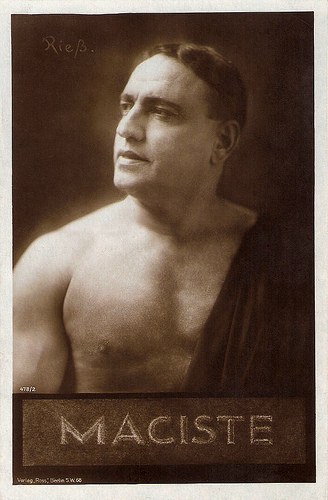
Bartolomeo Pagano alias Maciste. German postcard by Ross Verlag, no. 478/2, 1919-1924. Photo: Riess.
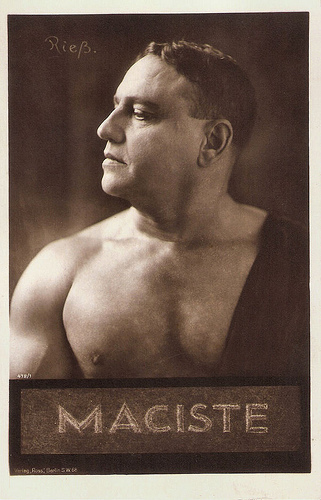
Bartolomeo Pagano alias Maciste. German postcard by Ross Verlag, no. 478/1, 1919-1924. Photo: Riess.
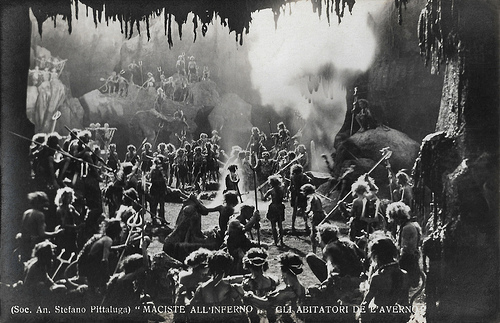
Italian postcard by Ed. A. Traldi, Milano. Photo: Dist. Società Anonima Stefano Pittaluga. Publicity still for Maciste all'inferno (Guido Brignone 1926). Caption: The Inhabitants of the Underworld.
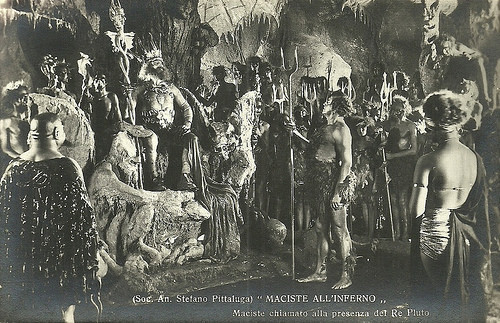
Italian postcard by Ed. A. Traldi, Milano. Photo: Dist. Società Anonima Stefano Pittaluga. Publicity still for Maciste all'inferno (Guido Brignone 1926). Caption: Maciste ( Bartolomeo Pagano ) called before king Pluto (Umberto Guarracino). At the right, seen on the back, Pluto's daughter Luciferina (Lucia Zanussi) is standing. The bold guy on the left must be Gerione (Mario Saio).

Italian postcard by Ed. A. Traldi, Milano. Photo: Dist. Società Anonima Stefano Pittaluga. Publicity still for Maciste all'inferno (Guido Brignone 1926), starring Bartolomeo Pagano as Maciste. Caption: The Tomb of the Heresiarchs [heretics].
A call for Maciste
In 1913, film director and producer Giovanni Pastrone, manager of the Itala company of Turin, released a call for the interpreter of the character of the Nubic slave Maciste (a character created together with Gabriele D’Annunzio) for Pastrone’s super-production Cabiria (1914).
Out of 50 candidates from all over Italy, Pastrone selected Bartolomeo Pagano . According to another version, it was actor Domenico Gambino who noticed Pagano and signalled him to Pastrone, who, impressed by his physique, hired him for his epic film.
Overnight Pagano became an international success because of his physique and his image of a courageous, humorous, and no-nonsensical defender of the weak. In Cabiria, he uses his power to rescue a Roman girl out of the hands of the Carthaginian priests who want to offer her to Moloch.
Pastrone immediately saw opportunities and launched a series of films just around his character, starting with a film just called Maciste (1915). Deliberately, Maciste’s part in Cabiria, the splendour of the Itala studio, and Maciste’s work there were shown to impress audiences and tie them to the previous box office hit.
Of course, the plot deals with a damsel in distress, whom Maciste saves with his muscles and his wit. During the First World War Pastrone used Maciste for war propaganda in Maciste alpino (1916), in which Maciste fiercely opposes the Austrian soldiers when he and his colleagues are captured during a film shoot on location.
The success of the film made Pastrone exploit Maciste in all kinds of situations and genres, but mostly in the adventure and crime genre: Maciste medium, Maciste atleta, Maciste poliziotto (all 1918), Maciste innamorato (1919), La trilogia di Maciste (1920), Maciste salvato dalle acque, Maciste in vacanza (both 1921).
By now Pastrone did not direct the films anymore but left this task to skilled directors like Luigi Romano Borgnetto. While not all of these were good productions, a better example was La Trilogia di Maciste by Carlo Campogalliani.
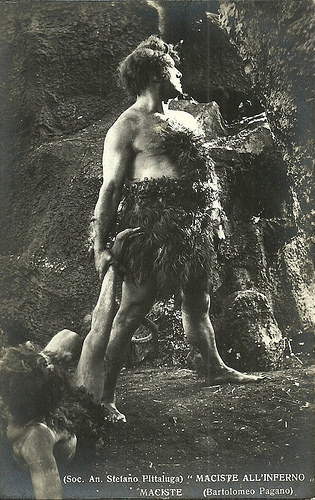
Italian postcard by Ed. A. Traldi, Milano. Photo: Dist. Società Anonima Stefano Pittaluga. Bartolomeo Pagano as Maciste in Maciste all'inferno (Guido Brignone, 1926).
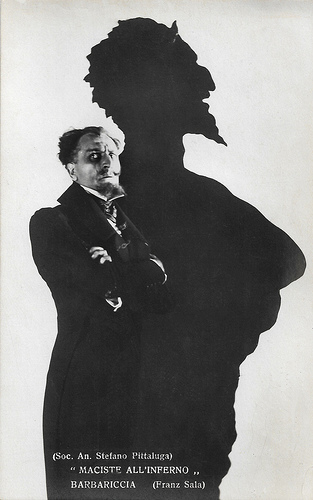
Italian postcard by Ed. A. Traldi, Milano. Photo: Dist. Società Anonima Stefano Pittaluga. Franz Sala as the devil Barbariccia in Maciste all’inferno (Guido Brigone, 1926). Franz Sala aka Francesco Sala (1886-1952) was a prolific actor of the Italian silent cinema, mostly playing the evil antagonist. In the 1930s he was active as a makeup artist.
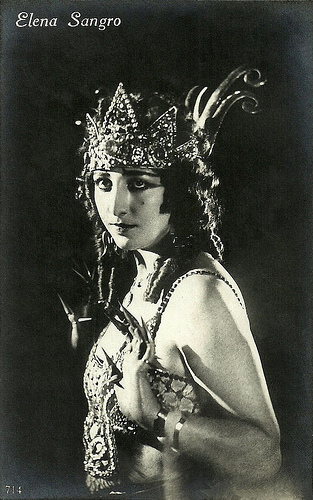
Italian postcard by Ed. A. Traldi, Milano, no. 714. Photo: Dist. Società Anonima Stefano Pittaluga. Elena Sangro as Proserpina, wife of Pluto, king of the underworld, in Maciste all'inferno (Guido Brignone, 1926).
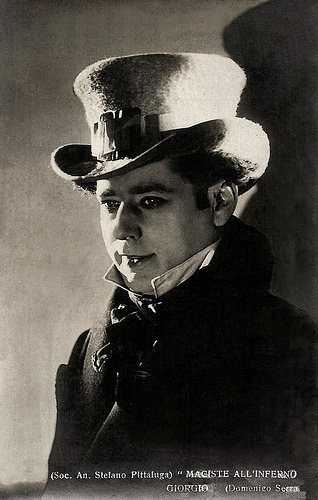
Italian postcard by Ed. A. Traldi, Milano. Photo: Dist. Società Anonima Stefano Pittaluga. Domenico Serra as Giorgio in Maciste all'inferno (Guido Brignone 1925).
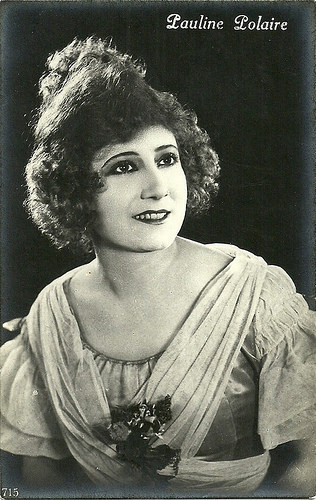
Italian postcard by Ed. A. Traldi, Milano, no. 715. Photo: Dist. Società Anonima Stefano Pittaluga. Pauline Polaire in Maciste all'inferno (Guido Brignone, 1926).
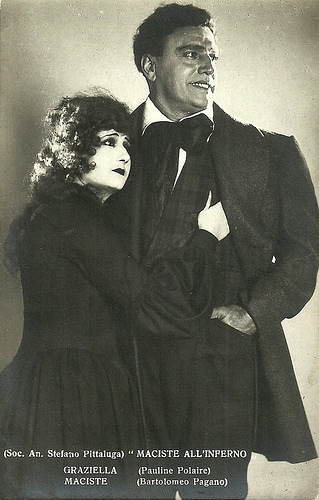
Italian postcard by Ed. A. Traldi, Milano. Photo: Dist. Società Anonima Stefano Pittaluga. Publicity still for Maciste all'inferno (Guido Brignone, 1926), starring Bartolomeo Pagano as Maciste and Pauline Polaire as Graziella.
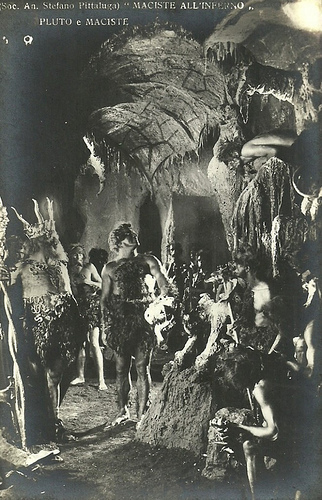
Italian postcard by Ed. A. Traldi, Milano. Photo: Dist. Società Anonima Stefano Pittaluga. Publicity still for Maciste all'inferno (Guido Brignone, 1926), starring Bartolomeo Pagano as Maciste and Umberto Guarracino as King Pluto.
The outside world didn’t know
In Italy a strong man or forzuti genre in film sprang up, creating space for characters such as Ausonia, Galaor, Ajax, and Sansone, and attracting competing for strong men and physical culture champions such as Giovanni Raicevich.
Pagano’s Maciste was also simply pirated abroad, such as by the French actor Michel Bonnet with his character Magiste, and another rip-off in Mexico. French critic Louis Delluc called him the Guitry of biceps, while newcomers Ultus ( Aurele Sydney ) and Douglas Fairbanks were launched as the British and the American Maciste.
In the late 1910s and early 1920s, Maciste’s popularity was biggest in Austria and Germany, despite the preceding anti-Austrian Maciste alpino. At home in Italy, Maciste’s image of superman coincided with the new fascist ideology. In the 1920s Pagano was one of the best-paid actors of his times, sometimes gaining 600.000 lire a year.
The Maciste-films continued until the early 1920s, when, not so much because of the collapse of the Italian film production but rather because of a fabulous contract, Pagano went to Berlin, the mecca of the European film industry. Here he stayed between 1921 and 1923, but according to the film press, he wasn’t as successful there as in Italy.
He played in Maciste und die Javanerin (Uwe Jenss Kraft, 1921), Maciste und die Tochter des Silberkönig (Luigi Romano Borgnetto, 1921), Maciste und der Sträfling Nr. 51 (Luigi Romano Borgnetto 1921), and Maciste und die Chinesische Truhe (Carl Boese, 1923).
Dissatisfied, Pagano returned to Italy, where producer Stefano Pittaluga immediately put him on a transatlantic for the film Maciste e il nipote d’America (Eleuterio Rodolfi, 1924), which included scenes shot in New York.
Among less convincing titles such as Maciste imperatore (Guido Brignone), the same Brignone directed Pagano in Maciste all’Inferno (Guido Brignone, 1926), a witty and artful pastiche on Dante, Doré, Méliès, Expressionism and medieval illustrations. It also contains ingenious special effects by ‘magician’ Segundo de Chomon.
The devil takes Maciste down to hell in an attempt to corrupt and ruin his morality.
When entering Hades, Maciste is being seduced by Proserpina, played by Italian diva Elena Sangro , and he turns into a hairy devil himself. The film was dear to Federico Fellini, because of its weird, fairy-tale-like atmosphere; the film supposedly inspired him to become a film director.
Bored with his Maciste films, Pagano asked and got different roles: Il vetturale del Moncenisio (Baldassarre Negroni, 1927), Giuditta e Oloferne (1928) starring Jia Ruskaja, and his last part (a secondary one by now) in L’ultimo Zar (Baldassarre Negroni, 1928).
Afflicted by diabetes, though, Pagano withdrew to his Villa Maciste in Sant’Ilario Ligure near Genua. Physical mishap destroyed his forces, typhoid reduced his weight in drastic ways, while arthritis even obliged him to spend his last years in a wheelchair. The outside world didn’t know.
Bartolomeo Pagano died in Genua on 24 June 1947, because of a heart attack. According to Italian film historian Vittorio Martinelli, Pagano never was a real actor, but rather the lively personification of a character from popular literature.
His character’s name though remains a synonym for power and courage. In 1960-1965 Maciste was revived in the sword and sandal films with Mark Forrest, Gordon Scott , Kirk Morris, Ed Fury, and other bodybuilders, while in the early 1970s Jesus Franco made two low-budget Maciste-films for French producers.
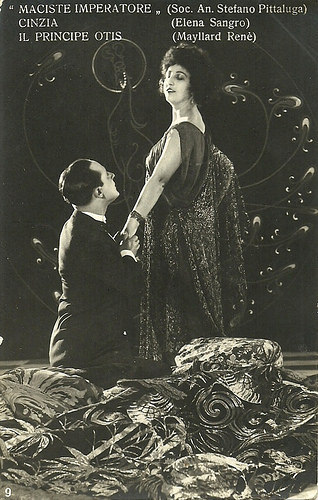
Italian postcard by Ed. A. Traldi, Milano, no. 9. Photo: Dist. Società Anonima Stefano Pittaluga. Elena Sangro as Cinzia and René [Raoul] Mayllard as prince Otis [Ortis] in the Fert production Maciste imperatore (Guido Brignone, 1924). In the kingdom of Sindagna, the prince regent Stanos tries with all means to dispose of the legitimate heir to the throne, prince Ortis. When Maciste and Saetta happen to be in the chaotic empire, they set things straight for the poor, weak prince. Maciste is proclaimed emperor of Sindagna after getting rid of the regent and his puppet ruler restores peace and arranges that the prince can also be united with his beloved one. The plotline comes close to Mussolini's take over of Italy, 'helping' the weak king Victor Emmanuel III and 'restoring order'.
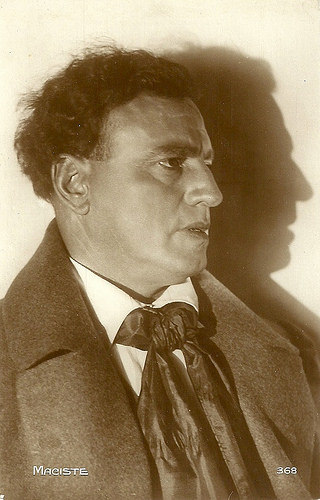
French postcard by Editions Cinémagazine, no. 368. Bartolomeo Pagano aka Maciste in Maciste all'inferno (Guido Brignone, 1926).
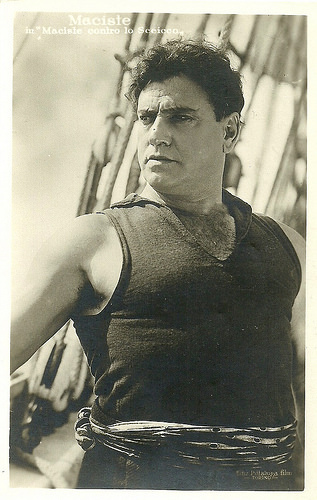
Italian postcard. Photo: Pittaluga Film, Turin. Maciste ( Bartolomeo Pagano ) in Maciste contro lo sceicco/Maciste against the Sheik (Mario Camerini, 1926).
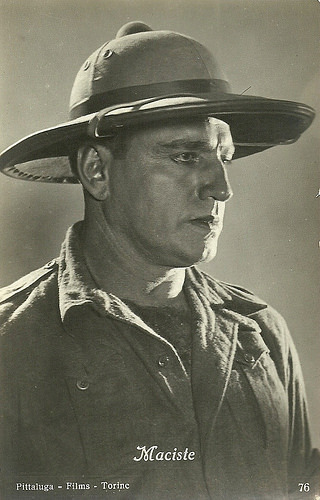
Italian postcard by Ed. A. Traldi, Milano, no. 76. Photo: Pittaluga Film, Turin. Maciste ( Bartolomeo Pagano ) in Maciste nella gabbia dei leoni/Maciste in the Lion's cage (Guido Brignone, 1926).
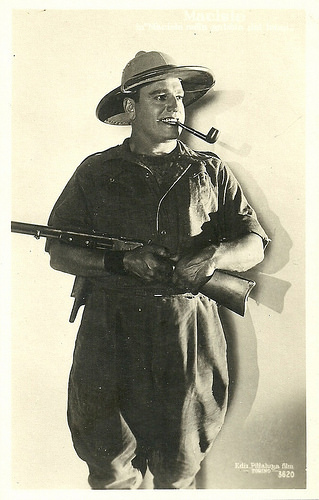
Italian postcard. Photo: Pittaluga Film, Turin. Maciste ( Bartolomeo Pagano ) in Maciste nella gabbia dei leoni/Maciste in the Lion's cage (Guido Brignone, 1926).
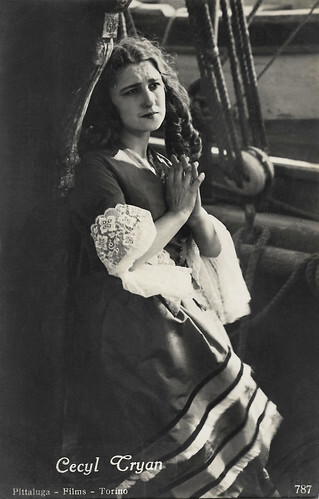
Italian postcard by Ed. A. Traldi, Milano, no. 787. Photo: Dist. Società Anonima Stefano Pittaluga. Cecyl Tryan in the Fert production Maciste contro lo sceicco/Maciste against the Sheik (Mario Camerini, 1926). Cecyl Tryan is the young girl whose tutor ( Franz Sala ) and his spendthrift mistress (Rita d'Harcourt) want to steal her inheritance and sell her to a sheik. Aboard the ship, she is menaced by the crew but a young sailor ( Lido Manetti ) and Maciste ( Bartolomeo Pagano ) rescue her. In the harbour, the sheik manages to abduct the girl and place her in his harem, but Maciste and the young man use power and wits to liberate her, defeat the sheik and sail back to Italy to set things straight there too.
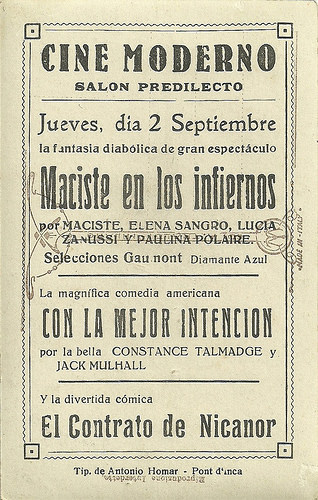
Spanish version of Italian postcard. Retro announcing Maciste all'inferno (Guido Brignone, 1926) at the Cine Moderno. Tipografia de Antonio Homar. Pont d'Inca. Thursday 2 September refers to the year 1926.
Sources: Vittorio Martinelli (Maciste & Co. I giganti buoni del cinema italiano - Italian), Wikipedia (Italian) and IMDb.

Bartolomeo Pagano alias Maciste. German postcard by Ross Verlag, no. 478/2, 1919-1924. Photo: Riess.

Bartolomeo Pagano alias Maciste. German postcard by Ross Verlag, no. 478/1, 1919-1924. Photo: Riess.

Italian postcard by Ed. A. Traldi, Milano. Photo: Dist. Società Anonima Stefano Pittaluga. Publicity still for Maciste all'inferno (Guido Brignone 1926). Caption: The Inhabitants of the Underworld.

Italian postcard by Ed. A. Traldi, Milano. Photo: Dist. Società Anonima Stefano Pittaluga. Publicity still for Maciste all'inferno (Guido Brignone 1926). Caption: Maciste ( Bartolomeo Pagano ) called before king Pluto (Umberto Guarracino). At the right, seen on the back, Pluto's daughter Luciferina (Lucia Zanussi) is standing. The bold guy on the left must be Gerione (Mario Saio).

Italian postcard by Ed. A. Traldi, Milano. Photo: Dist. Società Anonima Stefano Pittaluga. Publicity still for Maciste all'inferno (Guido Brignone 1926), starring Bartolomeo Pagano as Maciste. Caption: The Tomb of the Heresiarchs [heretics].
A call for Maciste
In 1913, film director and producer Giovanni Pastrone, manager of the Itala company of Turin, released a call for the interpreter of the character of the Nubic slave Maciste (a character created together with Gabriele D’Annunzio) for Pastrone’s super-production Cabiria (1914).
Out of 50 candidates from all over Italy, Pastrone selected Bartolomeo Pagano . According to another version, it was actor Domenico Gambino who noticed Pagano and signalled him to Pastrone, who, impressed by his physique, hired him for his epic film.
Overnight Pagano became an international success because of his physique and his image of a courageous, humorous, and no-nonsensical defender of the weak. In Cabiria, he uses his power to rescue a Roman girl out of the hands of the Carthaginian priests who want to offer her to Moloch.
Pastrone immediately saw opportunities and launched a series of films just around his character, starting with a film just called Maciste (1915). Deliberately, Maciste’s part in Cabiria, the splendour of the Itala studio, and Maciste’s work there were shown to impress audiences and tie them to the previous box office hit.
Of course, the plot deals with a damsel in distress, whom Maciste saves with his muscles and his wit. During the First World War Pastrone used Maciste for war propaganda in Maciste alpino (1916), in which Maciste fiercely opposes the Austrian soldiers when he and his colleagues are captured during a film shoot on location.
The success of the film made Pastrone exploit Maciste in all kinds of situations and genres, but mostly in the adventure and crime genre: Maciste medium, Maciste atleta, Maciste poliziotto (all 1918), Maciste innamorato (1919), La trilogia di Maciste (1920), Maciste salvato dalle acque, Maciste in vacanza (both 1921).
By now Pastrone did not direct the films anymore but left this task to skilled directors like Luigi Romano Borgnetto. While not all of these were good productions, a better example was La Trilogia di Maciste by Carlo Campogalliani.

Italian postcard by Ed. A. Traldi, Milano. Photo: Dist. Società Anonima Stefano Pittaluga. Bartolomeo Pagano as Maciste in Maciste all'inferno (Guido Brignone, 1926).

Italian postcard by Ed. A. Traldi, Milano. Photo: Dist. Società Anonima Stefano Pittaluga. Franz Sala as the devil Barbariccia in Maciste all’inferno (Guido Brigone, 1926). Franz Sala aka Francesco Sala (1886-1952) was a prolific actor of the Italian silent cinema, mostly playing the evil antagonist. In the 1930s he was active as a makeup artist.

Italian postcard by Ed. A. Traldi, Milano, no. 714. Photo: Dist. Società Anonima Stefano Pittaluga. Elena Sangro as Proserpina, wife of Pluto, king of the underworld, in Maciste all'inferno (Guido Brignone, 1926).

Italian postcard by Ed. A. Traldi, Milano. Photo: Dist. Società Anonima Stefano Pittaluga. Domenico Serra as Giorgio in Maciste all'inferno (Guido Brignone 1925).

Italian postcard by Ed. A. Traldi, Milano, no. 715. Photo: Dist. Società Anonima Stefano Pittaluga. Pauline Polaire in Maciste all'inferno (Guido Brignone, 1926).

Italian postcard by Ed. A. Traldi, Milano. Photo: Dist. Società Anonima Stefano Pittaluga. Publicity still for Maciste all'inferno (Guido Brignone, 1926), starring Bartolomeo Pagano as Maciste and Pauline Polaire as Graziella.

Italian postcard by Ed. A. Traldi, Milano. Photo: Dist. Società Anonima Stefano Pittaluga. Publicity still for Maciste all'inferno (Guido Brignone, 1926), starring Bartolomeo Pagano as Maciste and Umberto Guarracino as King Pluto.
The outside world didn’t know
In Italy a strong man or forzuti genre in film sprang up, creating space for characters such as Ausonia, Galaor, Ajax, and Sansone, and attracting competing for strong men and physical culture champions such as Giovanni Raicevich.
Pagano’s Maciste was also simply pirated abroad, such as by the French actor Michel Bonnet with his character Magiste, and another rip-off in Mexico. French critic Louis Delluc called him the Guitry of biceps, while newcomers Ultus ( Aurele Sydney ) and Douglas Fairbanks were launched as the British and the American Maciste.
In the late 1910s and early 1920s, Maciste’s popularity was biggest in Austria and Germany, despite the preceding anti-Austrian Maciste alpino. At home in Italy, Maciste’s image of superman coincided with the new fascist ideology. In the 1920s Pagano was one of the best-paid actors of his times, sometimes gaining 600.000 lire a year.
The Maciste-films continued until the early 1920s, when, not so much because of the collapse of the Italian film production but rather because of a fabulous contract, Pagano went to Berlin, the mecca of the European film industry. Here he stayed between 1921 and 1923, but according to the film press, he wasn’t as successful there as in Italy.
He played in Maciste und die Javanerin (Uwe Jenss Kraft, 1921), Maciste und die Tochter des Silberkönig (Luigi Romano Borgnetto, 1921), Maciste und der Sträfling Nr. 51 (Luigi Romano Borgnetto 1921), and Maciste und die Chinesische Truhe (Carl Boese, 1923).
Dissatisfied, Pagano returned to Italy, where producer Stefano Pittaluga immediately put him on a transatlantic for the film Maciste e il nipote d’America (Eleuterio Rodolfi, 1924), which included scenes shot in New York.
Among less convincing titles such as Maciste imperatore (Guido Brignone), the same Brignone directed Pagano in Maciste all’Inferno (Guido Brignone, 1926), a witty and artful pastiche on Dante, Doré, Méliès, Expressionism and medieval illustrations. It also contains ingenious special effects by ‘magician’ Segundo de Chomon.
The devil takes Maciste down to hell in an attempt to corrupt and ruin his morality.
When entering Hades, Maciste is being seduced by Proserpina, played by Italian diva Elena Sangro , and he turns into a hairy devil himself. The film was dear to Federico Fellini, because of its weird, fairy-tale-like atmosphere; the film supposedly inspired him to become a film director.
Bored with his Maciste films, Pagano asked and got different roles: Il vetturale del Moncenisio (Baldassarre Negroni, 1927), Giuditta e Oloferne (1928) starring Jia Ruskaja, and his last part (a secondary one by now) in L’ultimo Zar (Baldassarre Negroni, 1928).
Afflicted by diabetes, though, Pagano withdrew to his Villa Maciste in Sant’Ilario Ligure near Genua. Physical mishap destroyed his forces, typhoid reduced his weight in drastic ways, while arthritis even obliged him to spend his last years in a wheelchair. The outside world didn’t know.
Bartolomeo Pagano died in Genua on 24 June 1947, because of a heart attack. According to Italian film historian Vittorio Martinelli, Pagano never was a real actor, but rather the lively personification of a character from popular literature.
His character’s name though remains a synonym for power and courage. In 1960-1965 Maciste was revived in the sword and sandal films with Mark Forrest, Gordon Scott , Kirk Morris, Ed Fury, and other bodybuilders, while in the early 1970s Jesus Franco made two low-budget Maciste-films for French producers.

Italian postcard by Ed. A. Traldi, Milano, no. 9. Photo: Dist. Società Anonima Stefano Pittaluga. Elena Sangro as Cinzia and René [Raoul] Mayllard as prince Otis [Ortis] in the Fert production Maciste imperatore (Guido Brignone, 1924). In the kingdom of Sindagna, the prince regent Stanos tries with all means to dispose of the legitimate heir to the throne, prince Ortis. When Maciste and Saetta happen to be in the chaotic empire, they set things straight for the poor, weak prince. Maciste is proclaimed emperor of Sindagna after getting rid of the regent and his puppet ruler restores peace and arranges that the prince can also be united with his beloved one. The plotline comes close to Mussolini's take over of Italy, 'helping' the weak king Victor Emmanuel III and 'restoring order'.

French postcard by Editions Cinémagazine, no. 368. Bartolomeo Pagano aka Maciste in Maciste all'inferno (Guido Brignone, 1926).

Italian postcard. Photo: Pittaluga Film, Turin. Maciste ( Bartolomeo Pagano ) in Maciste contro lo sceicco/Maciste against the Sheik (Mario Camerini, 1926).

Italian postcard by Ed. A. Traldi, Milano, no. 76. Photo: Pittaluga Film, Turin. Maciste ( Bartolomeo Pagano ) in Maciste nella gabbia dei leoni/Maciste in the Lion's cage (Guido Brignone, 1926).

Italian postcard. Photo: Pittaluga Film, Turin. Maciste ( Bartolomeo Pagano ) in Maciste nella gabbia dei leoni/Maciste in the Lion's cage (Guido Brignone, 1926).

Italian postcard by Ed. A. Traldi, Milano, no. 787. Photo: Dist. Società Anonima Stefano Pittaluga. Cecyl Tryan in the Fert production Maciste contro lo sceicco/Maciste against the Sheik (Mario Camerini, 1926). Cecyl Tryan is the young girl whose tutor ( Franz Sala ) and his spendthrift mistress (Rita d'Harcourt) want to steal her inheritance and sell her to a sheik. Aboard the ship, she is menaced by the crew but a young sailor ( Lido Manetti ) and Maciste ( Bartolomeo Pagano ) rescue her. In the harbour, the sheik manages to abduct the girl and place her in his harem, but Maciste and the young man use power and wits to liberate her, defeat the sheik and sail back to Italy to set things straight there too.

Spanish version of Italian postcard. Retro announcing Maciste all'inferno (Guido Brignone, 1926) at the Cine Moderno. Tipografia de Antonio Homar. Pont d'Inca. Thursday 2 September refers to the year 1926.
Sources: Vittorio Martinelli (Maciste & Co. I giganti buoni del cinema italiano - Italian), Wikipedia (Italian) and IMDb.
Published on October 01, 2021 22:00
September 30, 2021
Directed by Jean Luc Godard
Jean-Luc Godard (1930) is a French film director and screenwriter. He is one of the most important members of the Nouvelle Vague (New Wave). Godard first received global acclaim for his feature À bout de souffle/Breathless (1959), helping to establish the New Wave movement. Godard's films have inspired many directors including Martin Scorsese, Quentin Tarantino, Robert Altman, Rainer Werner Fassbinder, and Wong Kar-wai. He has been married twice, to actresses Anna Karina and Anne Wiazemsky, both of whom starred in several of his films.
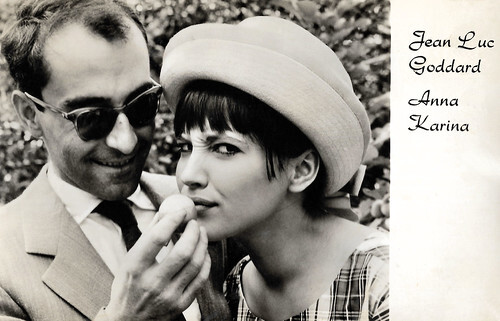
Dutch postcard by Gebr. Spanjerberg N.V., Rotterdam, no. 6100. Photo: Robert Lebeck / Combi Press, Amsterdam. Anna Karina and Jean-Luc Godard in Berlin, 1961. The couple was in Berlin for the presentation of Godard's third feature film Une femme est une femme/A Woman Is a Woman (Jean-Luc Godard, 1961) at the 11th Berlin International Film Festival. For her role in this film, Karina won the festival's Silver Bear award for Best Actress.

French postcard by Éditions Hazan, Paris, 1996. Photo: Raymond Depardon / Magnum. Caption: Jean Seberg and Jean-Luc Godard after the shooting of À bout de souffle.
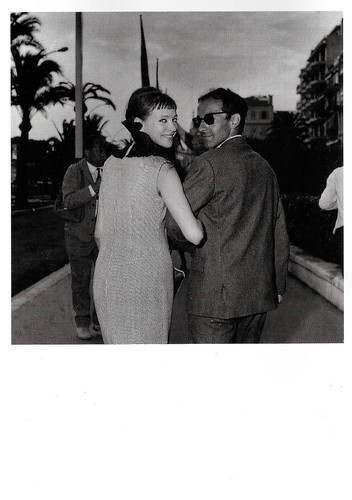
French postcard by Editions Cahiers du Cinéma, Paris, 1997. Photo: Traverso. Caption: Anna Karina and Jean-Luc Godard, Festival de Cannes 1963.
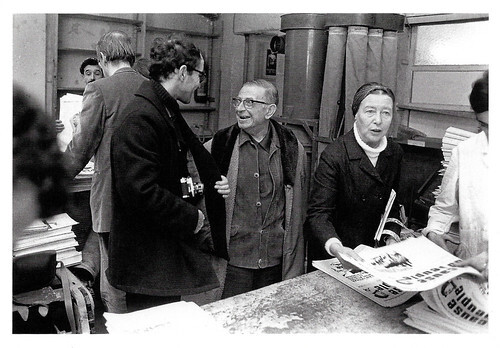
French postcard in the Collection Magie Noire by Éditions Hazan, Paris, 1994, no. 6430. Photo: Bruno Barbey / Magnum Photos. Jean-Luc Godard, Jean-Paul Sartre and Simone de Beauvoir, 1970.
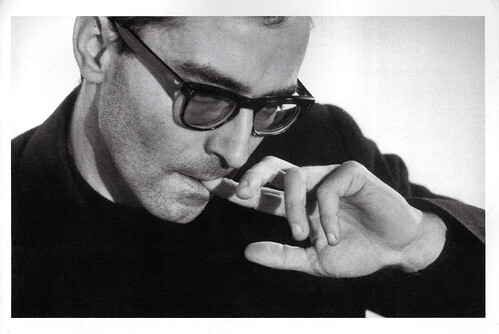
French postcard by La Cinémathèque française. Photo: Georges Pierre. Caption: Jean-Luc Godard, photo of the shooting of Pierrot le Fou, 1965.
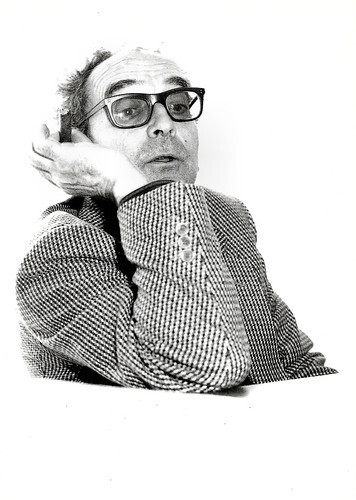
French postcard in the Collection Magie Noire by Éditions Hazan, Paris, 1988, no. 6077. Photo: Pierre-Olivier Deschamps / Agence Vu, Paris. Caption: Jean-Luc Godard, Mai 86.
Breaking with many then prevailing conventions
Jean-Luc Godard was born in Paris in 1930. His father was a doctor who owned a private clinic, and his mother came from a preeminent family of Swiss bankers. The family returned to Switzerland during World War II.
In 1949 he started studying ethnology at the Sorbonne. During this period he got to know François Truffaut, Jacques Rivette and Éric Rohmer. In 1950 he started a film newspaper 'Gazette du cinéma' with Rivette and Rohmer and collaborated on their films. In January 1952 he started writing for the film magazine 'Les Cahiers du cinéma', which had been founded the year before by André Bazin.
In 1953 he worked as a construction worker at a dam in Switzerland. With the money he earned, he made his first film, Opération Béton/Operation Concrete, a short documentary film about the construction of the dam. In 1956 he returned to France and resumed his work at Cahiers. During that time he made several short comedies and tributes to Mack Sennett and Jean Cocteau.
In 1959 he directed his first feature film, À bout de souffle/Breathless (1960), based on a screenplay by François Truffaut . This film played a key role in the birth of the Nouvelle Vague. It broke with many then prevailing conventions, with its references and influences from the American (gangster) film, the low budget, and the rough editing.
Jean-Paul Belmondo and Jean Seberg starred and the film was a huge success with audiences and critics. Godard won the Silver Bear for this film at the Berlin Film Festival 1960. Jean Seberg was nominated for a BAFTA Award. That year Godard also married Anna Karina , who would appear in many of his films. In 1964 they formed a production company, Anouchka Films. They divorced in 1965.
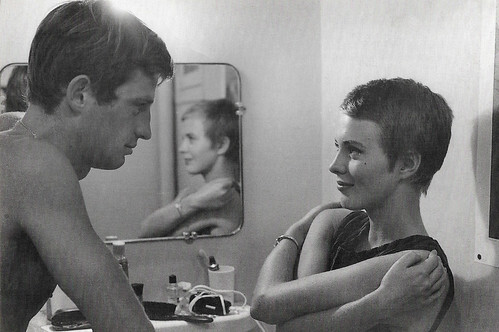
French postcard in the Collection Cinéma series by Editions Art & Scène, Paris, no. CF 29, 1995. Photo: Raymond Cauchetier, 1959. Jean-Paul Belmondo and Jean Seberg in A bout de souffle/Breathless (Jean-Luc Godard, 1960).
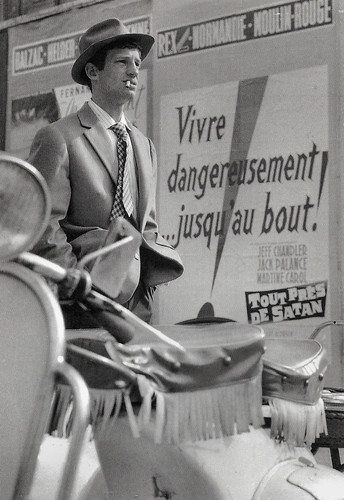
French postcard in the Collection Cinéma series by Editions Art & Scene, Paris, no. CF 83, 1995. Photo: Raymond Cauchetier, 1959. Jean-Paul Belmondo in A bout de souffle/Breathless (Jean-Luc Godard, 1960). In the background: the French poster for the American film Ten Seconds to Hell (Robert Aldrich, 1959). The caption translates as 'Right up close to Satan' comes very close.
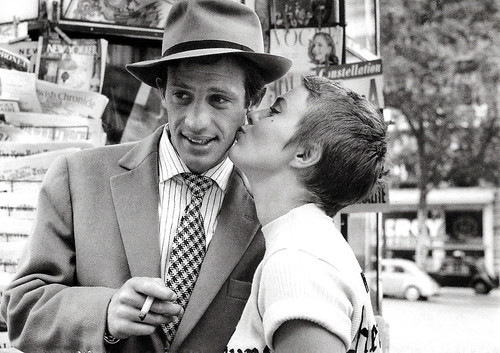
French postcard by Editions Art & Scene, no. CF 98, 1996. Photo: R. Cauchetier. Jean-Paul Belmondo and Jean Seberg in A bout de souffle/Breathless (Jean-Luc Godard, 1960).
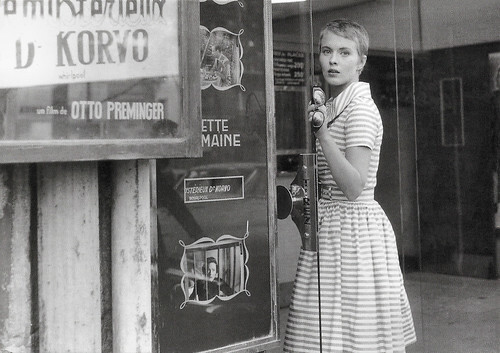
French postcard by Éditions Art & Scène, no. CF 107, 1996. Photo: R. Cauchetier. Jean Seberg in À bout de souffle/Breathless (Jean-Luc Godard, 1960).
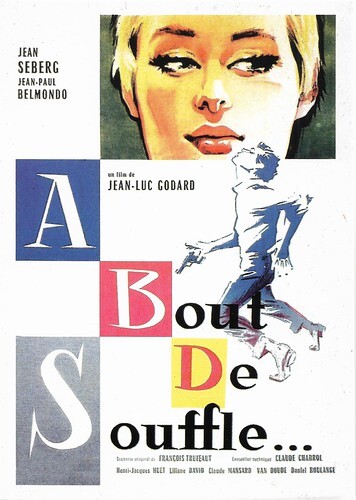
British postcard by Pyramid, Leicester. French poster for À bout de souffle/Breathless (Jean-Luc Godard, 1960).
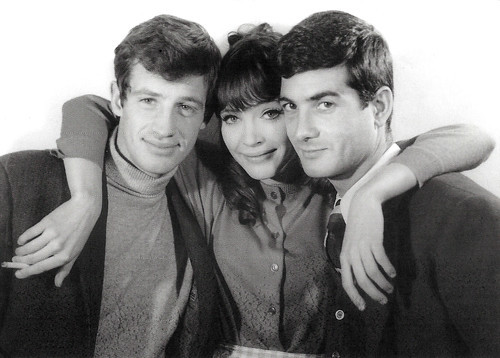
French postcard in the Collection Cinéma by Editions Art & Scene, Paris, no. CF 102, 1996. Photo: R. Cauchetier. Jean-Paul Belmondo , Anna Karina and Jean-Claude Brialy in Une femme est une femme/A Woman Is a Woman (Jean-Luc Godard, 1961).
Making political films political
In 1961 Jean-Luc Godard made his first colour film, the comedy Une femme est une femme/A Woman Is a Woman (1961) starring Anna Karina , Jean-Claude Brialy , and Jean-Paul Belmondo . It is a tribute to American musical comedy, filmed in cinemascope. Godard proved to be very productive during those years.
His first flop, the war film Les Carabiniers/The Carabineers (1963), was a tribute to Jean Vigo. That year he also made one of his greatest successes, Le Mépris/Contempt (1963) with Brigitte Bardot , Michel Piccoli , Jack Palance , and Fritz Lang .
Then followed Bande à part/Band of Outsiders (1964) with Anna Karina and Samy Frey , Pierrot le fou/Crazy Pierrot (1965) with Jean-Paul Belmondo and Anna Karina , and the Science-Fiction film Alphaville/Alphaville: A Strange Adventure of Lemmy Caution (1965) with Eddie Constantine . The film won the Golden Bear award of the 15th Berlin International Film Festival in 1965. Other films from those years were Masculin, feminin (1966) with Jean-Pierre Léaud , and Week-end (1967) with Mireille Darc .
Around the student uprisings of 1968, Godard became interested in Maoism. At that time he started an experimental political phase, which lasted until 1980. In the summer of 1968, together with Jean-Pierre Gorin, among others, he founded the Dziga Vertov Group, which wanted to make "political films political".
Some films from that time are Le Gai Savoir (1968), Pravda and One Plus One/Sympathy for the Devil (1968), the latter of which includes a unique recording of the studio build-up by the Rolling Stones of the classic 'Sympathy for the Devil'. In 1972 he made Tout va bien (1972), with Jane Fonda and Yves Montand in the lead roles, followed by Letter to Jane, a film about a photograph of Jane Fonda , which Gorin and Godard discuss. In 1972 he also met Anne-Marie Miéville, his later wife, with whom he made many films. This phase ended in 1980.
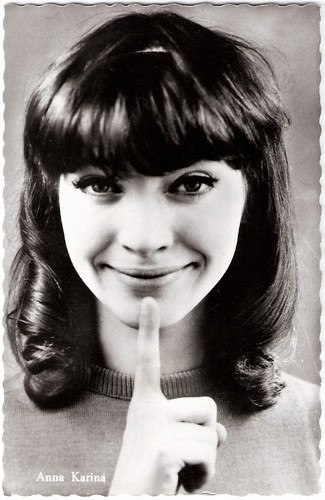
Dutch postcard by Hafbo film, no. 162. Anna Karina in Une femme est une femme/A Woman Is a Woman (Jean-Luc Godard, 1961).
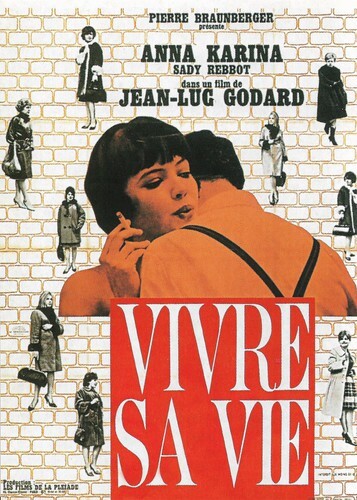
French postcard. French poster for Vivre sa vie/My Life to Live (Jean-Luc Godard, 1962).
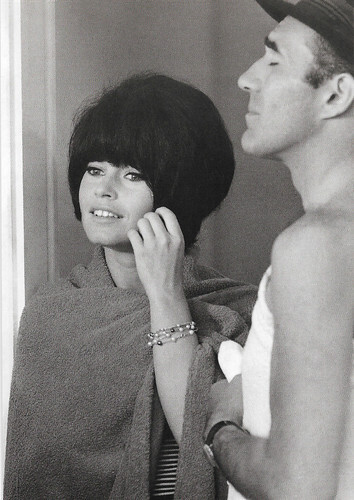
French postcard in the Collection Cinéma series by Editions Art & Scène, Paris, no. CF 101, 1996. Brigitte Bardot and Michel Piccoli in Le Mépris(Jean-Luc Godard, 1963).
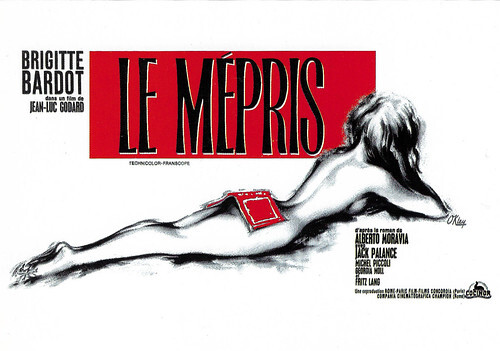
French postcard by BS, no. 31, 2005. French poster for Le Mépris (Jean-Luc Godard, 1963) starring Brigitte Bardot . Poster design: Pierre Okley, 1963.
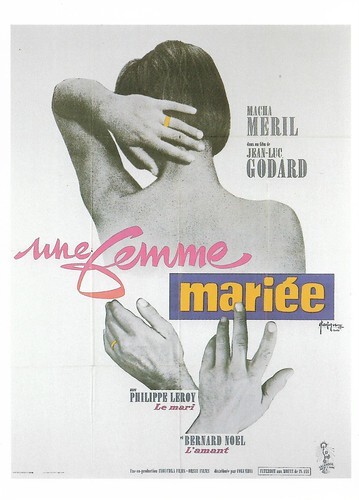
French postcard in the Collection Cinémathèque Suisse by CVB Publishers. French poster for Une femme mariée/A Married Woman (Jean-Luc Godard, 1964).
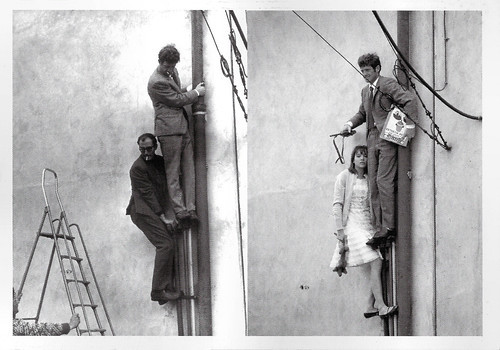
French postcard by La Cinémathèque Française. Photos: DR / Georges Pierre. Jean-Luc Godard, Jean-Paul Belmondo and Anna Karina during the shooting of Pierrot le Fou (Jean-Luc Godard, 1965).
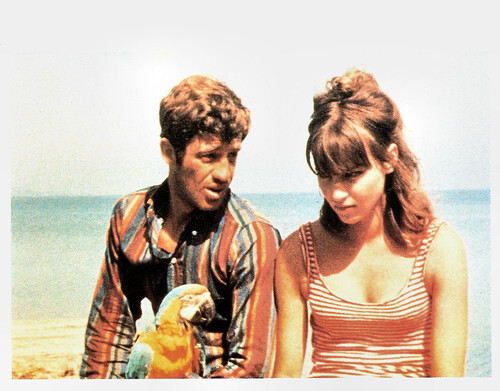
French postcard by La Cinémathèque française, no. CF 5006, 1998. Photo: UGC Da International. Anna Karina and Jean-Paul Belmondo in Pierrot le fou (Jean-Luc Godard, 1965).
Dismissed as blasphemy by the Catholic Church
After twelve years of low budget, militant left-wing, and otherwise experimental film and video projects outside of commercial distribution, Jean-Luc Godard's first film that was more mainstream and accessible again was the drama Sauve qui peut (la vie)/Every Man for Himself (1980) with Isabelle Huppert , Jacques Dutronc , and Nathalie Baye.
His films after that time are more autobiographical. For example, in Sauve qui peut (la vie)/Every Man for Himself there was a character named Godard. In 1982 and 1983 he made three related films Passion (1982), Prénom Carmen (1983) and Je vous salue, Marie (1984). The latter film was dismissed as blasphemy by the Catholic Church.
The film King Lear (1987), which he made with Norman Mailer, also caused controversy. It was a bizarre postmodern take on the Shakespeare play, with theatre director Peter Sellars as a descendant of Shakespeare, Burgess Meredith as the mobster Don Learo, Jean-Luc Godard as the professor, and Woody Allen as a character called Mr. Alien. Not entirely coincidentally, Mr. Alien was also nicknamed Jean-Luc Godard.
From 1989 to 1998, he made the series Histoire(s) du Cinéma, about the twentieth century and the history of film. His most recent film is the avantgarde essay Le Livre d'image/The Image Book (2018).
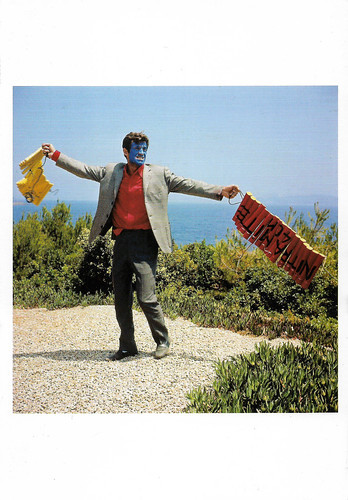
French postcard by La Cinémathèque française. Photo: Georges Pierre. Jean-Paul Belmondo in Pierrot le Fou (Jean-Luc Godard, 1965).
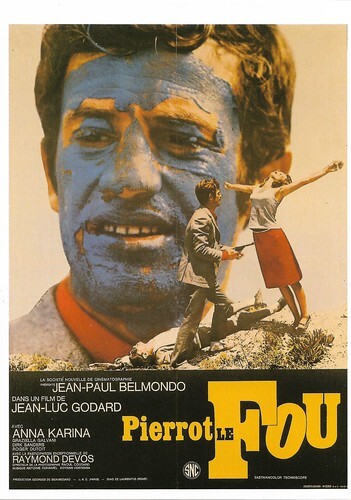
French postcard in the Collection Cinémathèque Suisse by CVB Publishers. French poster for Pierrot le fou/Pierrot Goes Wild (Jean-Luc Godard, 1965).
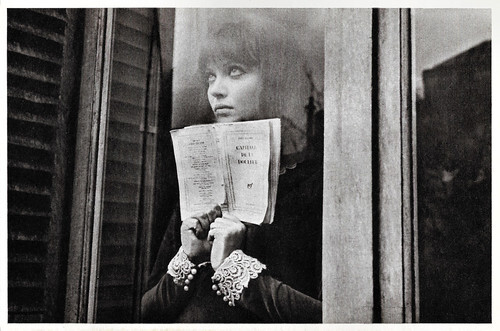
French postcard by Editions Le Malibran, Saint-Dié, no. CF 30. Photo: Georges Pierre. Anna Karina in Alphaville (Jean-Luc Godard, 1965). Photography: Raoul Coutard.
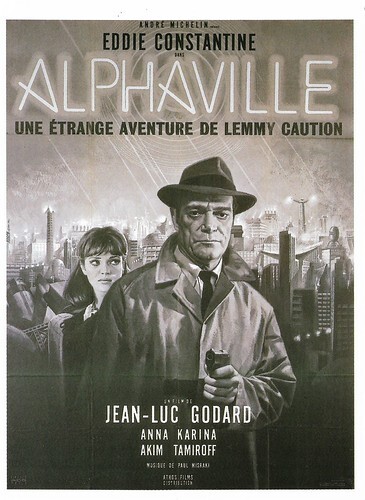
French postcard in the Collection Cinémathèque Suisse by CVB Publishers. French poster for Alphaville: une étrange aventure de Lemmy Caution/Alphaville: A Strange Adventure of Lemmy Caution (Jean-Luc Godard, 1965).
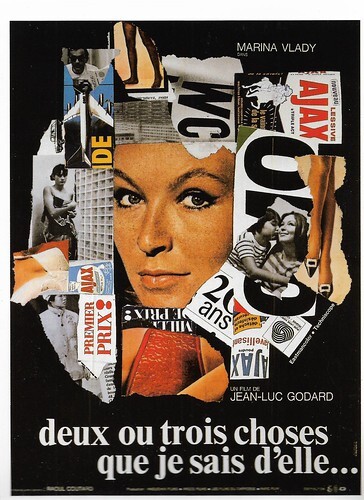
French postcard in the Collection Cinémathèque Suisse by CVB Publishers. French poster for Deux ou trois choses que je sais d'elle/Two or Three Things I Know About Her (Jean-Luc Godard, 1967).
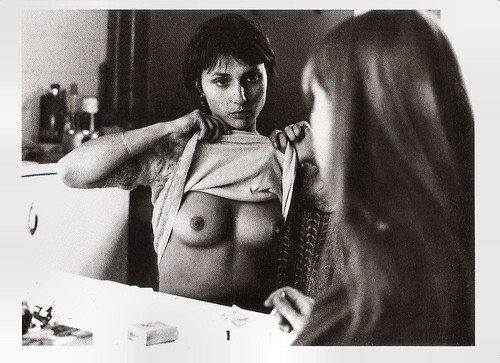
Vintage postcard by News Productions, Baulmes & Stroud / Filmwelt, Berlin, no. 56528. Photo: Collection Cinémathéque Suisse, Lausanne. Anna Baldaccini and Isabelle Huppert in Sauve qui peut (la vie)/Every Man for Himself (Jean-Luc Godard, 1980).
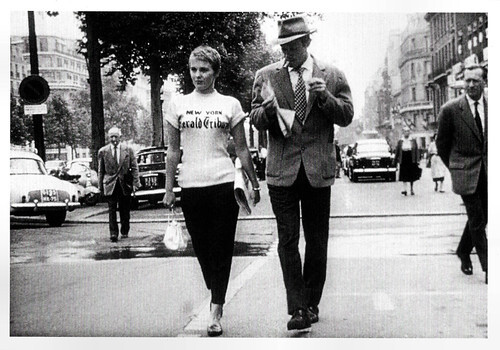
French postcard by La Cinémathèque française, no. CF 5009, 1998. Photo: UGC DA International. Jean-Paul Belmondo and Jean Seberg in A bout de souffle/Breathless (Jean-Luc Godard, 1960).
Sources: Wikipedia (Dutch and English), and .

Dutch postcard by Gebr. Spanjerberg N.V., Rotterdam, no. 6100. Photo: Robert Lebeck / Combi Press, Amsterdam. Anna Karina and Jean-Luc Godard in Berlin, 1961. The couple was in Berlin for the presentation of Godard's third feature film Une femme est une femme/A Woman Is a Woman (Jean-Luc Godard, 1961) at the 11th Berlin International Film Festival. For her role in this film, Karina won the festival's Silver Bear award for Best Actress.

French postcard by Éditions Hazan, Paris, 1996. Photo: Raymond Depardon / Magnum. Caption: Jean Seberg and Jean-Luc Godard after the shooting of À bout de souffle.

French postcard by Editions Cahiers du Cinéma, Paris, 1997. Photo: Traverso. Caption: Anna Karina and Jean-Luc Godard, Festival de Cannes 1963.

French postcard in the Collection Magie Noire by Éditions Hazan, Paris, 1994, no. 6430. Photo: Bruno Barbey / Magnum Photos. Jean-Luc Godard, Jean-Paul Sartre and Simone de Beauvoir, 1970.

French postcard by La Cinémathèque française. Photo: Georges Pierre. Caption: Jean-Luc Godard, photo of the shooting of Pierrot le Fou, 1965.

French postcard in the Collection Magie Noire by Éditions Hazan, Paris, 1988, no. 6077. Photo: Pierre-Olivier Deschamps / Agence Vu, Paris. Caption: Jean-Luc Godard, Mai 86.
Breaking with many then prevailing conventions
Jean-Luc Godard was born in Paris in 1930. His father was a doctor who owned a private clinic, and his mother came from a preeminent family of Swiss bankers. The family returned to Switzerland during World War II.
In 1949 he started studying ethnology at the Sorbonne. During this period he got to know François Truffaut, Jacques Rivette and Éric Rohmer. In 1950 he started a film newspaper 'Gazette du cinéma' with Rivette and Rohmer and collaborated on their films. In January 1952 he started writing for the film magazine 'Les Cahiers du cinéma', which had been founded the year before by André Bazin.
In 1953 he worked as a construction worker at a dam in Switzerland. With the money he earned, he made his first film, Opération Béton/Operation Concrete, a short documentary film about the construction of the dam. In 1956 he returned to France and resumed his work at Cahiers. During that time he made several short comedies and tributes to Mack Sennett and Jean Cocteau.
In 1959 he directed his first feature film, À bout de souffle/Breathless (1960), based on a screenplay by François Truffaut . This film played a key role in the birth of the Nouvelle Vague. It broke with many then prevailing conventions, with its references and influences from the American (gangster) film, the low budget, and the rough editing.
Jean-Paul Belmondo and Jean Seberg starred and the film was a huge success with audiences and critics. Godard won the Silver Bear for this film at the Berlin Film Festival 1960. Jean Seberg was nominated for a BAFTA Award. That year Godard also married Anna Karina , who would appear in many of his films. In 1964 they formed a production company, Anouchka Films. They divorced in 1965.

French postcard in the Collection Cinéma series by Editions Art & Scène, Paris, no. CF 29, 1995. Photo: Raymond Cauchetier, 1959. Jean-Paul Belmondo and Jean Seberg in A bout de souffle/Breathless (Jean-Luc Godard, 1960).

French postcard in the Collection Cinéma series by Editions Art & Scene, Paris, no. CF 83, 1995. Photo: Raymond Cauchetier, 1959. Jean-Paul Belmondo in A bout de souffle/Breathless (Jean-Luc Godard, 1960). In the background: the French poster for the American film Ten Seconds to Hell (Robert Aldrich, 1959). The caption translates as 'Right up close to Satan' comes very close.

French postcard by Editions Art & Scene, no. CF 98, 1996. Photo: R. Cauchetier. Jean-Paul Belmondo and Jean Seberg in A bout de souffle/Breathless (Jean-Luc Godard, 1960).

French postcard by Éditions Art & Scène, no. CF 107, 1996. Photo: R. Cauchetier. Jean Seberg in À bout de souffle/Breathless (Jean-Luc Godard, 1960).

British postcard by Pyramid, Leicester. French poster for À bout de souffle/Breathless (Jean-Luc Godard, 1960).

French postcard in the Collection Cinéma by Editions Art & Scene, Paris, no. CF 102, 1996. Photo: R. Cauchetier. Jean-Paul Belmondo , Anna Karina and Jean-Claude Brialy in Une femme est une femme/A Woman Is a Woman (Jean-Luc Godard, 1961).
Making political films political
In 1961 Jean-Luc Godard made his first colour film, the comedy Une femme est une femme/A Woman Is a Woman (1961) starring Anna Karina , Jean-Claude Brialy , and Jean-Paul Belmondo . It is a tribute to American musical comedy, filmed in cinemascope. Godard proved to be very productive during those years.
His first flop, the war film Les Carabiniers/The Carabineers (1963), was a tribute to Jean Vigo. That year he also made one of his greatest successes, Le Mépris/Contempt (1963) with Brigitte Bardot , Michel Piccoli , Jack Palance , and Fritz Lang .
Then followed Bande à part/Band of Outsiders (1964) with Anna Karina and Samy Frey , Pierrot le fou/Crazy Pierrot (1965) with Jean-Paul Belmondo and Anna Karina , and the Science-Fiction film Alphaville/Alphaville: A Strange Adventure of Lemmy Caution (1965) with Eddie Constantine . The film won the Golden Bear award of the 15th Berlin International Film Festival in 1965. Other films from those years were Masculin, feminin (1966) with Jean-Pierre Léaud , and Week-end (1967) with Mireille Darc .
Around the student uprisings of 1968, Godard became interested in Maoism. At that time he started an experimental political phase, which lasted until 1980. In the summer of 1968, together with Jean-Pierre Gorin, among others, he founded the Dziga Vertov Group, which wanted to make "political films political".
Some films from that time are Le Gai Savoir (1968), Pravda and One Plus One/Sympathy for the Devil (1968), the latter of which includes a unique recording of the studio build-up by the Rolling Stones of the classic 'Sympathy for the Devil'. In 1972 he made Tout va bien (1972), with Jane Fonda and Yves Montand in the lead roles, followed by Letter to Jane, a film about a photograph of Jane Fonda , which Gorin and Godard discuss. In 1972 he also met Anne-Marie Miéville, his later wife, with whom he made many films. This phase ended in 1980.

Dutch postcard by Hafbo film, no. 162. Anna Karina in Une femme est une femme/A Woman Is a Woman (Jean-Luc Godard, 1961).

French postcard. French poster for Vivre sa vie/My Life to Live (Jean-Luc Godard, 1962).

French postcard in the Collection Cinéma series by Editions Art & Scène, Paris, no. CF 101, 1996. Brigitte Bardot and Michel Piccoli in Le Mépris(Jean-Luc Godard, 1963).

French postcard by BS, no. 31, 2005. French poster for Le Mépris (Jean-Luc Godard, 1963) starring Brigitte Bardot . Poster design: Pierre Okley, 1963.

French postcard in the Collection Cinémathèque Suisse by CVB Publishers. French poster for Une femme mariée/A Married Woman (Jean-Luc Godard, 1964).

French postcard by La Cinémathèque Française. Photos: DR / Georges Pierre. Jean-Luc Godard, Jean-Paul Belmondo and Anna Karina during the shooting of Pierrot le Fou (Jean-Luc Godard, 1965).

French postcard by La Cinémathèque française, no. CF 5006, 1998. Photo: UGC Da International. Anna Karina and Jean-Paul Belmondo in Pierrot le fou (Jean-Luc Godard, 1965).
Dismissed as blasphemy by the Catholic Church
After twelve years of low budget, militant left-wing, and otherwise experimental film and video projects outside of commercial distribution, Jean-Luc Godard's first film that was more mainstream and accessible again was the drama Sauve qui peut (la vie)/Every Man for Himself (1980) with Isabelle Huppert , Jacques Dutronc , and Nathalie Baye.
His films after that time are more autobiographical. For example, in Sauve qui peut (la vie)/Every Man for Himself there was a character named Godard. In 1982 and 1983 he made three related films Passion (1982), Prénom Carmen (1983) and Je vous salue, Marie (1984). The latter film was dismissed as blasphemy by the Catholic Church.
The film King Lear (1987), which he made with Norman Mailer, also caused controversy. It was a bizarre postmodern take on the Shakespeare play, with theatre director Peter Sellars as a descendant of Shakespeare, Burgess Meredith as the mobster Don Learo, Jean-Luc Godard as the professor, and Woody Allen as a character called Mr. Alien. Not entirely coincidentally, Mr. Alien was also nicknamed Jean-Luc Godard.
From 1989 to 1998, he made the series Histoire(s) du Cinéma, about the twentieth century and the history of film. His most recent film is the avantgarde essay Le Livre d'image/The Image Book (2018).

French postcard by La Cinémathèque française. Photo: Georges Pierre. Jean-Paul Belmondo in Pierrot le Fou (Jean-Luc Godard, 1965).

French postcard in the Collection Cinémathèque Suisse by CVB Publishers. French poster for Pierrot le fou/Pierrot Goes Wild (Jean-Luc Godard, 1965).

French postcard by Editions Le Malibran, Saint-Dié, no. CF 30. Photo: Georges Pierre. Anna Karina in Alphaville (Jean-Luc Godard, 1965). Photography: Raoul Coutard.

French postcard in the Collection Cinémathèque Suisse by CVB Publishers. French poster for Alphaville: une étrange aventure de Lemmy Caution/Alphaville: A Strange Adventure of Lemmy Caution (Jean-Luc Godard, 1965).

French postcard in the Collection Cinémathèque Suisse by CVB Publishers. French poster for Deux ou trois choses que je sais d'elle/Two or Three Things I Know About Her (Jean-Luc Godard, 1967).

Vintage postcard by News Productions, Baulmes & Stroud / Filmwelt, Berlin, no. 56528. Photo: Collection Cinémathéque Suisse, Lausanne. Anna Baldaccini and Isabelle Huppert in Sauve qui peut (la vie)/Every Man for Himself (Jean-Luc Godard, 1980).

French postcard by La Cinémathèque française, no. CF 5009, 1998. Photo: UGC DA International. Jean-Paul Belmondo and Jean Seberg in A bout de souffle/Breathless (Jean-Luc Godard, 1960).
Sources: Wikipedia (Dutch and English), and .
Published on September 30, 2021 22:00
September 29, 2021
Charles Morton
Charles Morton (1908-1966) was a good-looking and athletic American film and television actor. His film career started as a leading man in the silent era in films by John Ford and Friedrich Wilhelm Murnau. Morton continued into sound features and finally acted on television.
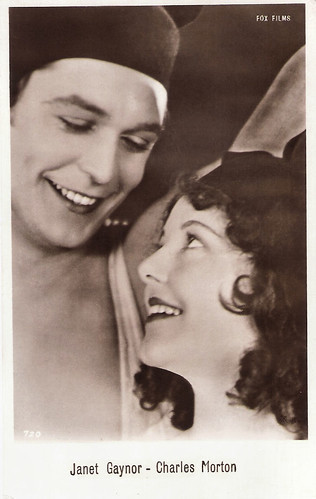
Italian postcard by G.B. Falci Editore, Milano, no. 720. Photo: Max Munn Autrey / Fox. Janet Gaynor and Charles Morton in 4 Devils (Friedrich Wilhelm Murnau, 1928).
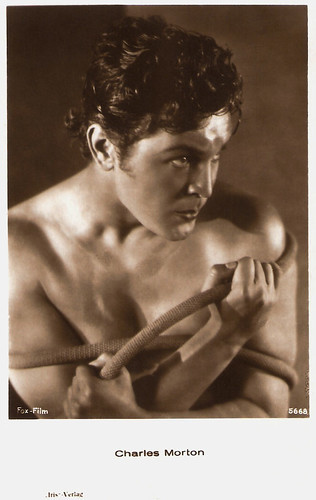
Austrian postcard by Iris-Verlag, no. 5668. Photo: Fox-Film.
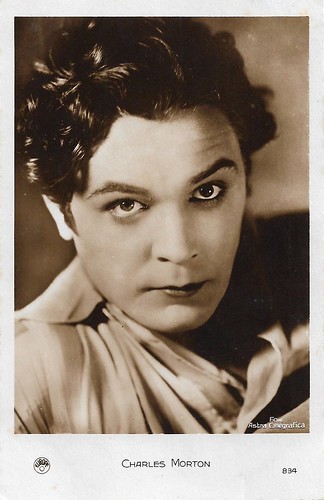
French postcard by Europe, no. 834. Photo: Fox / Astra Cinegrafica.
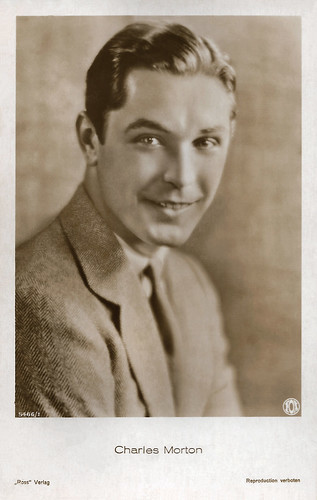
German postcard by Ross Verlag, no. 5466/1, 1930-1931. Photo: Fox.
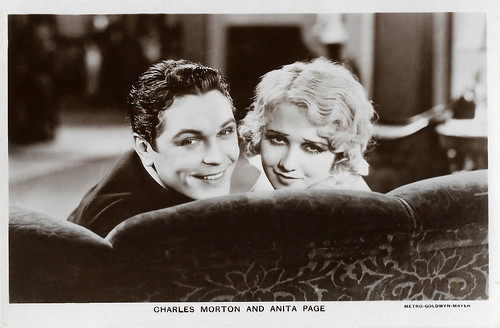
British postcard in the Film Partners Series, London, no. PC 64. Photo: Metro-Goldwyn-Mayer. Charles Morton and Anita Page in Caught Short (Charles Reisner, 1930).
The most mourned of the lost films of the silent era
Charles Morton was born in 1908 in Illinois, USA. Morton spent his adolescence in Madison, Wisconsin, and received his education at Madison High School and the University of Wisconsin–Madison.
He made his first stage appearance at the age of seven and later appeared in vaudeville, stock, and the legitimate stage. At the age of 19, Charles was discovered by film director Randall Faye while starring in a stage production of 'Romeo and Juliet' in Los Angeles. Impressed by his polished physical appearance, personality, and youthful charm, he arranged for him to be a career in the film industry.
Morton signed his first contract with Fox in 1927. Under the supervision of Randall Faye, he made his film debut in Rich But Honest (1927). Audiences first discovered the handsome youth that same year as the dashing Terry O'Flynn opposite the studio's leading flapper, Madge Bellamy , in Colleen (Frank O'Connor, 1927), one of the era's many comedy-dramas.
Morton went on to star in John Ford's World War I silent film Four Sons (1928) with Margaret Mann and James Hall. It is one of only a handful of survivors out of the more than 50 silent films Ford directed between 1917 and 1928. He also starred in Fox's None but the Brave (Albert Ray, 1928) with Sally Phipps as Mary.
Charles Morton was also a member of the ultimately tragic circus troupe in F. W. Murnau's near-classic 4 Devils, among the most mourned of the lost films of the silent era. The plot concerns four orphans ( Janet Gaynor , Nancy Drexel, Barry Norton, and Charles Morton) who are raised by an old clown and become a high wire act. But there are sinister goings-on at a circus. 4 Devils was released by Fox Film Corporation and was produced by William Fox, who had hired Murnau to come to the United States. It was initially released as a silent with a synchronised music score and sound effects in October 1928 and grossed $100,000 in New York City, but because of the talkie picture craze, Fox pulled it from distribution and ordered sound to be added. No copies of either version of the film are known to exist.
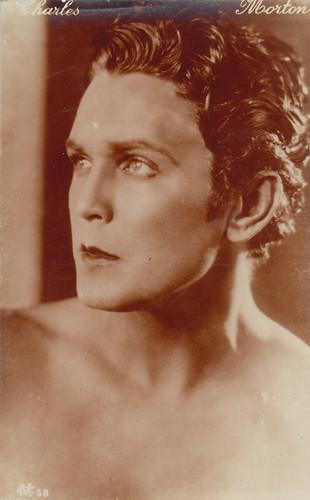
Spanish postcard by “MC Barcelona”, no. 58. Collection: Marlene Pilaete.
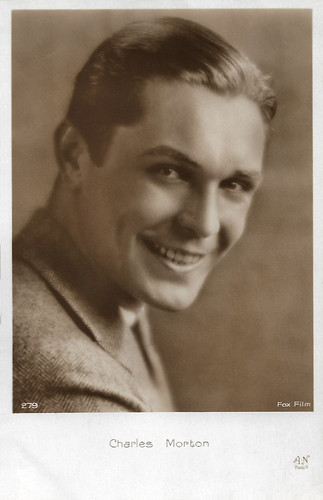
French postcard by A.N., Paris, no. 279. Photo: Fox Film.
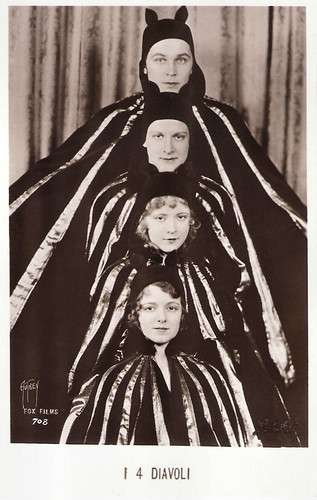
Italian postcard by G.B. Falci Editore, Milano, no. 708. Photo: Max Munn Autrey / Fox. Janet Gaynor , Nancy Drexel, Barry Norton, and Charles Morton in 4 Devils (Friedrich Wilhelm Murnau, 1928).
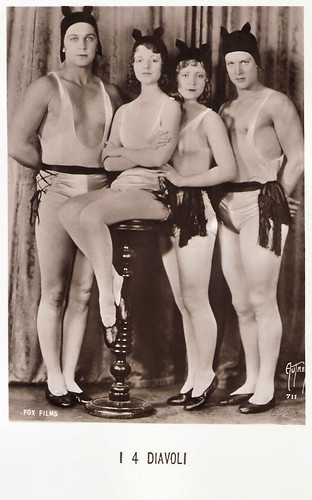
Italian postcard by G.B. Falci Editore, Milano, no. 711 Photo: Charles Munn Autrey / Fox. Charles Morton, Janet Gaynor , Nancy Drexel, and Barry Norton in 4 Devils (Friedrich Wilhelm Murnau, 1928).
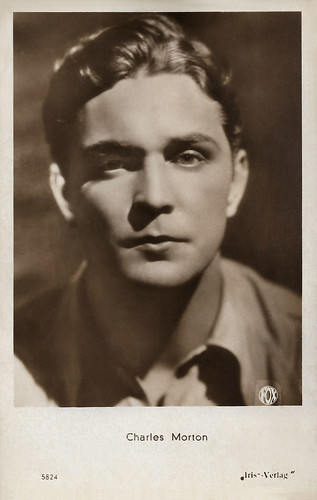
Austrian postcard by Iris-Verlag, no. 5824. Photo: Fox.
A few days behind bars
Charles Morton had a supporting part in the sound comedy Check and Double Check (Melville W. Brown, 1930) based on the Amos 'n' Andy radio show. The title was derived from a catchphrase associated with the show. It starred Charles Correll and Freeman Gosden, in blackface, in the roles of Andy and Amos, respectively, which they had created for the radio show. The film also featured Duke Ellington and his Cotton Club Orchestra.
In 1931, Charles Morton married Lya Lys, but the marriage ended in divorce some months later, not long after the birth of their daughter. Later a dispute over alimony payments would see Morton spending a few days behind bars.
After 1933 with the widespread use of sound film, Morton's career began to lose momentum; and by 1936 his roles were significantly reduced, playing minor roles on television until his death from heart disease in 1966, at the age of 58.
Even though Charles Morton's career continued into the mid-1960s, almost all of his roles after 1933 were so minor he was left uncredited for the majority of his performances.
Charles Morton was cremated and his ashes interred in an unmarked grave in Valhalla Memorial Park, North Hollywood, Los Angeles County, California. According to IMDb, he was married three times. His wives were Lya Lys, Frances Lane, and Lola Resk.
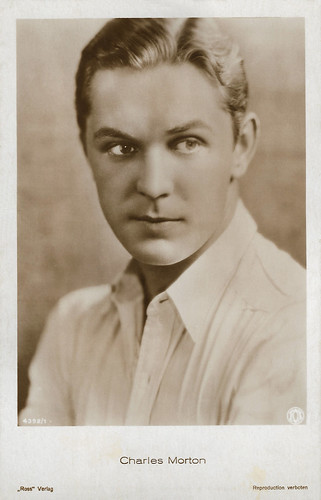
German postcard by Ross Verlag, no. 4392/1, 1929-1930. Photo: Fox.
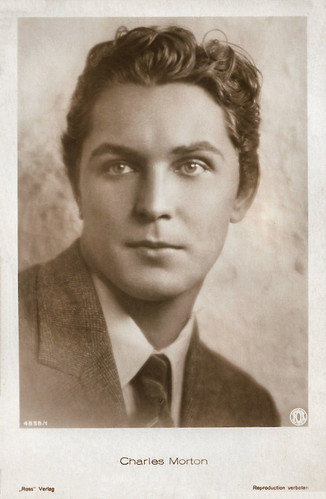
German postcard by Ross Verlag, no. 4858/1, 1929-1930. Photo: Fox.
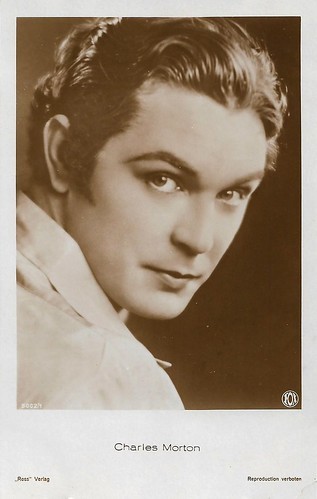
German postcard by Ross Verlag, no. 5002/1, 1930-1931. Photo: Fox.
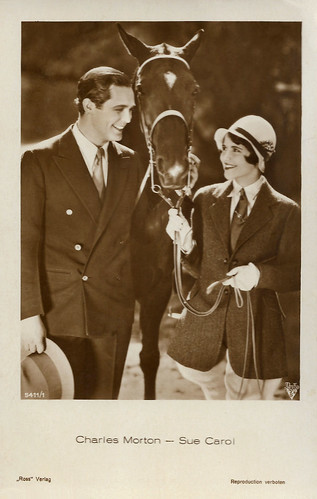
German postcard by Ross Verlag, no. 5411/1, 1930-1931. Photo: RKO Radio Pictures. Charles Morton and Sue Carol in Check and Double Check (Melville W. Brown, 1930).
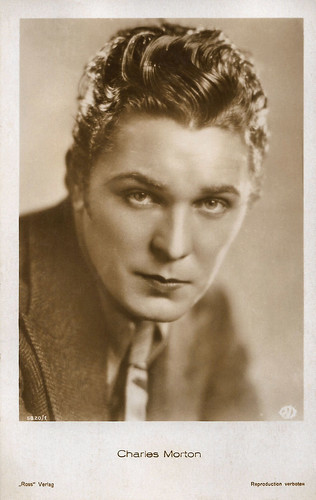
German postcard by Ross Verlag, no. 5820/1, 1930-1931. Photo: Fox.
Source: Lowell Thurgood (Find A Grave), Wikipedia, and .

Italian postcard by G.B. Falci Editore, Milano, no. 720. Photo: Max Munn Autrey / Fox. Janet Gaynor and Charles Morton in 4 Devils (Friedrich Wilhelm Murnau, 1928).

Austrian postcard by Iris-Verlag, no. 5668. Photo: Fox-Film.

French postcard by Europe, no. 834. Photo: Fox / Astra Cinegrafica.

German postcard by Ross Verlag, no. 5466/1, 1930-1931. Photo: Fox.

British postcard in the Film Partners Series, London, no. PC 64. Photo: Metro-Goldwyn-Mayer. Charles Morton and Anita Page in Caught Short (Charles Reisner, 1930).
The most mourned of the lost films of the silent era
Charles Morton was born in 1908 in Illinois, USA. Morton spent his adolescence in Madison, Wisconsin, and received his education at Madison High School and the University of Wisconsin–Madison.
He made his first stage appearance at the age of seven and later appeared in vaudeville, stock, and the legitimate stage. At the age of 19, Charles was discovered by film director Randall Faye while starring in a stage production of 'Romeo and Juliet' in Los Angeles. Impressed by his polished physical appearance, personality, and youthful charm, he arranged for him to be a career in the film industry.
Morton signed his first contract with Fox in 1927. Under the supervision of Randall Faye, he made his film debut in Rich But Honest (1927). Audiences first discovered the handsome youth that same year as the dashing Terry O'Flynn opposite the studio's leading flapper, Madge Bellamy , in Colleen (Frank O'Connor, 1927), one of the era's many comedy-dramas.
Morton went on to star in John Ford's World War I silent film Four Sons (1928) with Margaret Mann and James Hall. It is one of only a handful of survivors out of the more than 50 silent films Ford directed between 1917 and 1928. He also starred in Fox's None but the Brave (Albert Ray, 1928) with Sally Phipps as Mary.
Charles Morton was also a member of the ultimately tragic circus troupe in F. W. Murnau's near-classic 4 Devils, among the most mourned of the lost films of the silent era. The plot concerns four orphans ( Janet Gaynor , Nancy Drexel, Barry Norton, and Charles Morton) who are raised by an old clown and become a high wire act. But there are sinister goings-on at a circus. 4 Devils was released by Fox Film Corporation and was produced by William Fox, who had hired Murnau to come to the United States. It was initially released as a silent with a synchronised music score and sound effects in October 1928 and grossed $100,000 in New York City, but because of the talkie picture craze, Fox pulled it from distribution and ordered sound to be added. No copies of either version of the film are known to exist.

Spanish postcard by “MC Barcelona”, no. 58. Collection: Marlene Pilaete.

French postcard by A.N., Paris, no. 279. Photo: Fox Film.

Italian postcard by G.B. Falci Editore, Milano, no. 708. Photo: Max Munn Autrey / Fox. Janet Gaynor , Nancy Drexel, Barry Norton, and Charles Morton in 4 Devils (Friedrich Wilhelm Murnau, 1928).

Italian postcard by G.B. Falci Editore, Milano, no. 711 Photo: Charles Munn Autrey / Fox. Charles Morton, Janet Gaynor , Nancy Drexel, and Barry Norton in 4 Devils (Friedrich Wilhelm Murnau, 1928).

Austrian postcard by Iris-Verlag, no. 5824. Photo: Fox.
A few days behind bars
Charles Morton had a supporting part in the sound comedy Check and Double Check (Melville W. Brown, 1930) based on the Amos 'n' Andy radio show. The title was derived from a catchphrase associated with the show. It starred Charles Correll and Freeman Gosden, in blackface, in the roles of Andy and Amos, respectively, which they had created for the radio show. The film also featured Duke Ellington and his Cotton Club Orchestra.
In 1931, Charles Morton married Lya Lys, but the marriage ended in divorce some months later, not long after the birth of their daughter. Later a dispute over alimony payments would see Morton spending a few days behind bars.
After 1933 with the widespread use of sound film, Morton's career began to lose momentum; and by 1936 his roles were significantly reduced, playing minor roles on television until his death from heart disease in 1966, at the age of 58.
Even though Charles Morton's career continued into the mid-1960s, almost all of his roles after 1933 were so minor he was left uncredited for the majority of his performances.
Charles Morton was cremated and his ashes interred in an unmarked grave in Valhalla Memorial Park, North Hollywood, Los Angeles County, California. According to IMDb, he was married three times. His wives were Lya Lys, Frances Lane, and Lola Resk.

German postcard by Ross Verlag, no. 4392/1, 1929-1930. Photo: Fox.

German postcard by Ross Verlag, no. 4858/1, 1929-1930. Photo: Fox.

German postcard by Ross Verlag, no. 5002/1, 1930-1931. Photo: Fox.

German postcard by Ross Verlag, no. 5411/1, 1930-1931. Photo: RKO Radio Pictures. Charles Morton and Sue Carol in Check and Double Check (Melville W. Brown, 1930).

German postcard by Ross Verlag, no. 5820/1, 1930-1931. Photo: Fox.
Source: Lowell Thurgood (Find A Grave), Wikipedia, and .
Published on September 29, 2021 22:00
September 28, 2021
Ferdinand Bonn
Ferdinand Bonn (1861-1933) was a German actor, playwright, and theatre director. Between 1914 and 1932 he had a career in German and Austrian silent and early sound cinema.
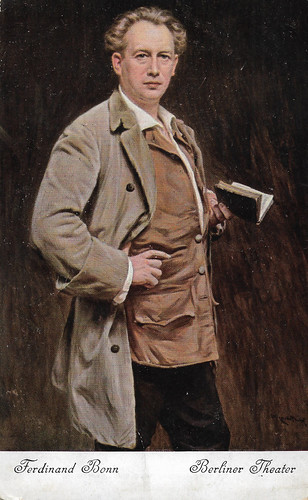
German postcard by Meisenbach Riffarth & Co. Berlin. Artwork: Berliner Theater.
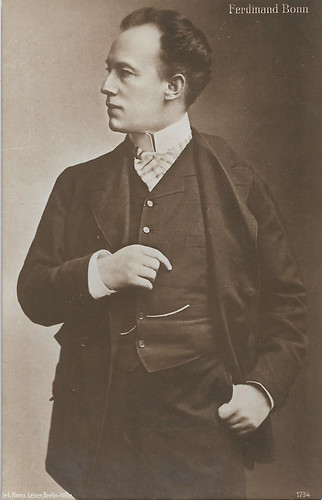
German postcard by Verlag Hermann Leiser, no. 1734.
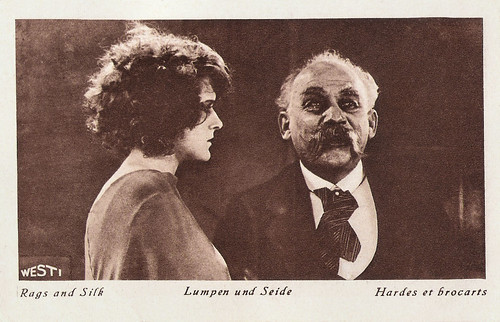
German postcard. Photo: Westi, Berlin. Mary Kid and Ferdinand Bonn in Lumpen und Seide/Rags and Silk (Richard Oswald, 1925).
The talk of the town
Ferdinand Franz Josef Bonn, who later used the pseudonyms Florian Endli and Franz Baier, was born in 1861 in Donauwörth in Bavaria. He was the son of Franz and Bertha Bonn, née Promoli. Franz already wrote his own plays while still at school, in which he himself took part.
In 1880 he graduated from the Wilhelmsgymnasium in Munich and began studying law at the University of Munich. He turned first to painting and then to acting. Bonn took acting lessons with Ernst Possart and made his debut in 1885 at the Nuremberg City Theatre as the Dervish in 'Nathan the Wise'. In the same year, he played at the Deutsches Theater in Moscow and stayed there for one season. Later he acted in Munich and at the Burgtheater in Vienna, where he became known as Hamlet, Franz Moor in 'Die Räuber', and Raskolnikov in 'Schuld und Sühne'.
In 1905 he founded Ferdinand Bonn's Berliner Theater in Berlin. Numerous stage plays written by Bonn were premiered here. He "professed an aesthetic style that deliberately employed an exuberant set and all kinds of stage effects." His directorship of the Berlin theatre lasted only two years and was, according to theatre historian Peter W. Marx, "artistically and economically a failure".
Nevertheless, Bonn "made himself and his theatre the talk of the town," among other things by using live animals on stage. He adapted tales by Arthur Conan Doyle about the master detective Sherlock Holmes with himself as Holmes, namely 'Sherlock Holmes' in 1906, and 'The Hound of the Baskervilles' and 'The Dancing Men' in 1907. His patriotic stage drama 'Der junge Fritz' was banned by Kaiser Wilhelm II, who had attended another of the Sherlock Holmes performances, to which Bonn reacted strongly.
In 1911, Bonn staged Shakespeare's drama 'Richard III' at the Circus Busch, taking the lead role himself. The spectacular performance, which was largely rejected by critics, was particularly marked by the use of numerous live horses, which earned Bonn the derisive name of "Pferdinand" ('Pferd'is the German noun for 'horse'). He was forced to declare bankruptcy before the First World War and then went back to touring the theatre.
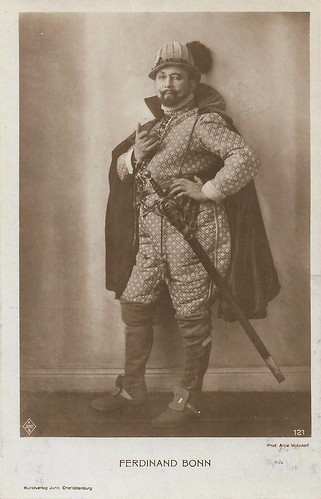
German postcard by Kunstverlag Juno, (Berlin-)Charlottenburg, no. 121. Photo: Alice Mitzdorf. Ferdinand Bonn as Lord Leicester in the play 'Mary Stuart' by Friedrich Schiller.
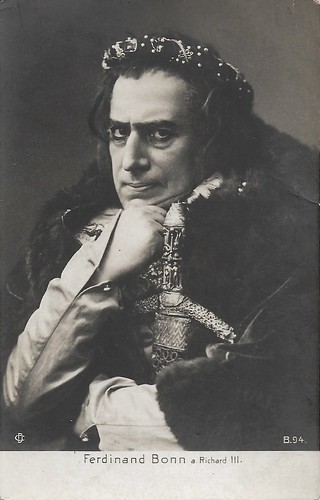
German postcard by CD, no. B.94. Ferdinand Bonn as Richard III in a stage production of 'Richard III' by William Shakespeare. He performed this role for the first time in 1892 at the Burgtheater in Vienna, Austria, and later repeated the role many times including at the Circus Busch in Berlin in 1911.
A private screening for the King of Bavaria
In the film, Ferdinand Bonn started in some Danish productions for Nordisk. First, he was the scriptwriter of the Sherlock Holmes adaptation Den stjaalne millionobligation/The Stolen Legacy (N.N., 1911), starring Alwin Neuss . Soon after, he played father figures in four Nordisk films directed by August Blom: Historien om en moder/The Tragedy of a Mother (1912) with Ragna Wettergreen, Hjærternes Kamp/A High Stake (1912) also with Robert Dinesen and Else Frölich , Elskovs Magt/Man's Great Adversary (1913) with Valdemar Psilander , and Hans vanskeligste Rolle/His Most Difficult Part (1913) with again Dinesen and Fröhlich.
In 1913, Bonn became famous with Ludwig II. von Bayern/ Ludwig II of Bavaria. He played the title role but he also produced the film. He screened this film in private for the King of Bavaria. It was highly acclaimed although IMDb doesn't mention the film. After four more films produced by his own company, Bonn started to act in films by Richard Oswald: Lache, Bajazzo/Laugh Bajazzo (1914), Die Geschichte der stillen Mühle/The Silent Mill (1914), and Hampels Abenteuer/Hampel's adventures (1914).
Then he acted in Max Mack's Der Katzensteg/The cat footbridge (Max Mack, 1915). In Mack's film Robert und Bertram, die lustigen Vagabunden/Robert and Bertram (Max Mack, 1915), Ernst Lubitsch starred alongside him. During the First World War Bonn acted with various firms such as Berliner Film Manufaktur, Oliver, Deuko, and Frankfurter Film Co. With the latter, he starred as a famous elderly stage actor in Don Juans letztes Abenteuer/Don Juan's last adventure (Heinz Carl Heiland, 1918). In the late 1910s, he did various films with Carl Heinz Wolff for the Kowo company, such as Die rätselhafte Sphinx (1919) and with Friedrich Zelnik and Karl Grüne for Zelnik's company Berliner Film-Manufaktur, such as Hölle der Jungfrauen (Friedrich Zelnik, 1919), Menschen in Ketten (Karl Grüne, 1919), and Manon (Friedrich Zelnik, 1920) with Lya Mara .
In 1920 Ferdinand Bonn once again portrayed the fairytale king Ludwig II in Das Schweigen am Starnberger See/The silence on Lake Starnberg (Rolf Raffé, 1921). Bonn played again under the direction of Richard Oswald. He preferred to play detectives and in 1919 he impersonated both Kaiser Wilhelm II and der Hauptmann von Köpenick in Kaiser Wilhelm's Glück und Ende/Kaiser Wilhelm's happiness and end (Willy Achsel, 1920).
In 1920 Bonn made one film in Hungary: Végszó/Cue (Miklós Pásztory, 1920). Between 1920 and 1924 he appeared in Austrian films including two German-Austrian coproductions by Oswald, and the Jewish themed Der Fluch/The Curse (Robert Land, 1924). From 1924 Bonn acted in German cinema again, but by now he got mostly smaller roles. He still had two major supporting parts in Oswald's comedy Eine tolle Nacht/A Crazy Night (Richard Oswald, 1927) with Ossi Oswalda and Harry Liedtke , and Victor Janson 's comedy Donauwalzer/Blue Danube Waltz (Victor Janson, 1929), Bonn's last silent film.
In the sound era, Bonn still did a handful of films, but apart from So lang' noch ein Walzer von Strauß erklingt/A Waltz by Strauss (Conrad Wiene, 1931), his roles were bit parts, even uncredited. He continued to act until his death in 1933, lastly in Friederike/Frederica (Fritz Friedmann-Frederich, 1932) starring Mady Christians. Ferdinand Bonn passed away in 1933 in Berlin. He was 71. In his first marriage, Bonn was married to a sister of the opera singer Emma Moerdes.
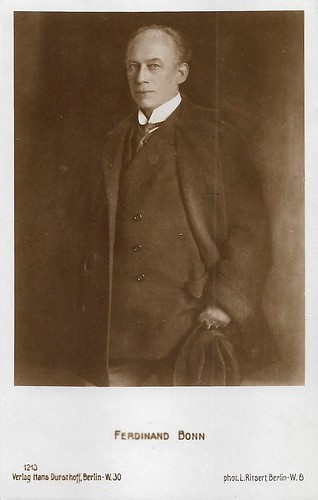
German postcard by Verlag Hans Dursthoff, Berlin, no. 1213, Photo: L. Ritsert, Berlin.
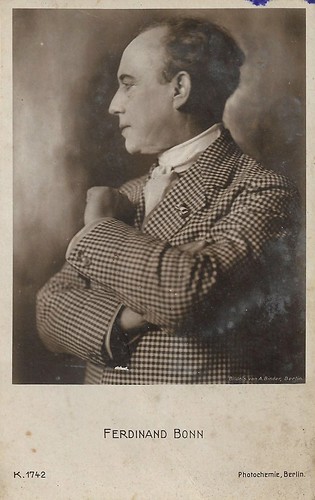
German postcard by Photochemie, Berlin, no. K. 1742. Photo: A. (Alex) Binder, Berlin.
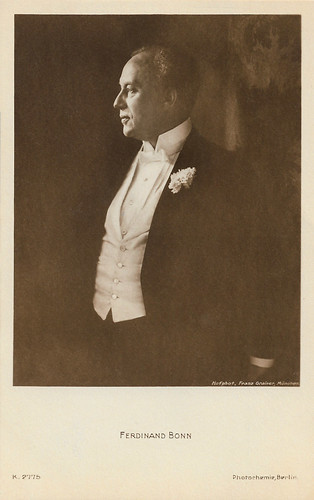
German postcard by Photochemie, Berlin, no. K. 2775. Photo: Franz Grainer, München. Grainer was a court photographer.
Sources: Wikipedia (German and English), , and Filmdatabasen.

German postcard by Meisenbach Riffarth & Co. Berlin. Artwork: Berliner Theater.

German postcard by Verlag Hermann Leiser, no. 1734.

German postcard. Photo: Westi, Berlin. Mary Kid and Ferdinand Bonn in Lumpen und Seide/Rags and Silk (Richard Oswald, 1925).
The talk of the town
Ferdinand Franz Josef Bonn, who later used the pseudonyms Florian Endli and Franz Baier, was born in 1861 in Donauwörth in Bavaria. He was the son of Franz and Bertha Bonn, née Promoli. Franz already wrote his own plays while still at school, in which he himself took part.
In 1880 he graduated from the Wilhelmsgymnasium in Munich and began studying law at the University of Munich. He turned first to painting and then to acting. Bonn took acting lessons with Ernst Possart and made his debut in 1885 at the Nuremberg City Theatre as the Dervish in 'Nathan the Wise'. In the same year, he played at the Deutsches Theater in Moscow and stayed there for one season. Later he acted in Munich and at the Burgtheater in Vienna, where he became known as Hamlet, Franz Moor in 'Die Räuber', and Raskolnikov in 'Schuld und Sühne'.
In 1905 he founded Ferdinand Bonn's Berliner Theater in Berlin. Numerous stage plays written by Bonn were premiered here. He "professed an aesthetic style that deliberately employed an exuberant set and all kinds of stage effects." His directorship of the Berlin theatre lasted only two years and was, according to theatre historian Peter W. Marx, "artistically and economically a failure".
Nevertheless, Bonn "made himself and his theatre the talk of the town," among other things by using live animals on stage. He adapted tales by Arthur Conan Doyle about the master detective Sherlock Holmes with himself as Holmes, namely 'Sherlock Holmes' in 1906, and 'The Hound of the Baskervilles' and 'The Dancing Men' in 1907. His patriotic stage drama 'Der junge Fritz' was banned by Kaiser Wilhelm II, who had attended another of the Sherlock Holmes performances, to which Bonn reacted strongly.
In 1911, Bonn staged Shakespeare's drama 'Richard III' at the Circus Busch, taking the lead role himself. The spectacular performance, which was largely rejected by critics, was particularly marked by the use of numerous live horses, which earned Bonn the derisive name of "Pferdinand" ('Pferd'is the German noun for 'horse'). He was forced to declare bankruptcy before the First World War and then went back to touring the theatre.

German postcard by Kunstverlag Juno, (Berlin-)Charlottenburg, no. 121. Photo: Alice Mitzdorf. Ferdinand Bonn as Lord Leicester in the play 'Mary Stuart' by Friedrich Schiller.

German postcard by CD, no. B.94. Ferdinand Bonn as Richard III in a stage production of 'Richard III' by William Shakespeare. He performed this role for the first time in 1892 at the Burgtheater in Vienna, Austria, and later repeated the role many times including at the Circus Busch in Berlin in 1911.
A private screening for the King of Bavaria
In the film, Ferdinand Bonn started in some Danish productions for Nordisk. First, he was the scriptwriter of the Sherlock Holmes adaptation Den stjaalne millionobligation/The Stolen Legacy (N.N., 1911), starring Alwin Neuss . Soon after, he played father figures in four Nordisk films directed by August Blom: Historien om en moder/The Tragedy of a Mother (1912) with Ragna Wettergreen, Hjærternes Kamp/A High Stake (1912) also with Robert Dinesen and Else Frölich , Elskovs Magt/Man's Great Adversary (1913) with Valdemar Psilander , and Hans vanskeligste Rolle/His Most Difficult Part (1913) with again Dinesen and Fröhlich.
In 1913, Bonn became famous with Ludwig II. von Bayern/ Ludwig II of Bavaria. He played the title role but he also produced the film. He screened this film in private for the King of Bavaria. It was highly acclaimed although IMDb doesn't mention the film. After four more films produced by his own company, Bonn started to act in films by Richard Oswald: Lache, Bajazzo/Laugh Bajazzo (1914), Die Geschichte der stillen Mühle/The Silent Mill (1914), and Hampels Abenteuer/Hampel's adventures (1914).
Then he acted in Max Mack's Der Katzensteg/The cat footbridge (Max Mack, 1915). In Mack's film Robert und Bertram, die lustigen Vagabunden/Robert and Bertram (Max Mack, 1915), Ernst Lubitsch starred alongside him. During the First World War Bonn acted with various firms such as Berliner Film Manufaktur, Oliver, Deuko, and Frankfurter Film Co. With the latter, he starred as a famous elderly stage actor in Don Juans letztes Abenteuer/Don Juan's last adventure (Heinz Carl Heiland, 1918). In the late 1910s, he did various films with Carl Heinz Wolff for the Kowo company, such as Die rätselhafte Sphinx (1919) and with Friedrich Zelnik and Karl Grüne for Zelnik's company Berliner Film-Manufaktur, such as Hölle der Jungfrauen (Friedrich Zelnik, 1919), Menschen in Ketten (Karl Grüne, 1919), and Manon (Friedrich Zelnik, 1920) with Lya Mara .
In 1920 Ferdinand Bonn once again portrayed the fairytale king Ludwig II in Das Schweigen am Starnberger See/The silence on Lake Starnberg (Rolf Raffé, 1921). Bonn played again under the direction of Richard Oswald. He preferred to play detectives and in 1919 he impersonated both Kaiser Wilhelm II and der Hauptmann von Köpenick in Kaiser Wilhelm's Glück und Ende/Kaiser Wilhelm's happiness and end (Willy Achsel, 1920).
In 1920 Bonn made one film in Hungary: Végszó/Cue (Miklós Pásztory, 1920). Between 1920 and 1924 he appeared in Austrian films including two German-Austrian coproductions by Oswald, and the Jewish themed Der Fluch/The Curse (Robert Land, 1924). From 1924 Bonn acted in German cinema again, but by now he got mostly smaller roles. He still had two major supporting parts in Oswald's comedy Eine tolle Nacht/A Crazy Night (Richard Oswald, 1927) with Ossi Oswalda and Harry Liedtke , and Victor Janson 's comedy Donauwalzer/Blue Danube Waltz (Victor Janson, 1929), Bonn's last silent film.
In the sound era, Bonn still did a handful of films, but apart from So lang' noch ein Walzer von Strauß erklingt/A Waltz by Strauss (Conrad Wiene, 1931), his roles were bit parts, even uncredited. He continued to act until his death in 1933, lastly in Friederike/Frederica (Fritz Friedmann-Frederich, 1932) starring Mady Christians. Ferdinand Bonn passed away in 1933 in Berlin. He was 71. In his first marriage, Bonn was married to a sister of the opera singer Emma Moerdes.

German postcard by Verlag Hans Dursthoff, Berlin, no. 1213, Photo: L. Ritsert, Berlin.

German postcard by Photochemie, Berlin, no. K. 1742. Photo: A. (Alex) Binder, Berlin.

German postcard by Photochemie, Berlin, no. K. 2775. Photo: Franz Grainer, München. Grainer was a court photographer.
Sources: Wikipedia (German and English), , and Filmdatabasen.
Published on September 28, 2021 22:00
September 27, 2021
Batman Forever (1995)
Batman Forever (Joel Schumacher, 1995), produced by Tim Burton, was the third installment of Warner Bros' initial Batman film series. It is a loose sequel to Batman Returns (1992). Val Kilmer took over the role of Batman/Bruce Wayne from Michael Keaton. Kilmer's co-stars were Tommy Lee Jones, Jim Carrey, Nicole Kidman, Chris O'Donnell, and Michael Gough. Batman Forever was a success at the box office, despite receiving mixed reviews from critics.
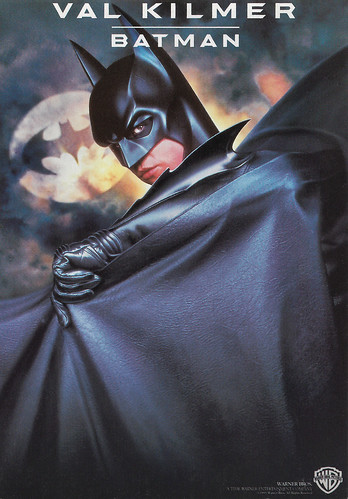
Belgian postcard by Boomerang Free Cards. Photo: Warner Bros. Val Kilmer in Batman Forever (Joel Schumacher, 1995).
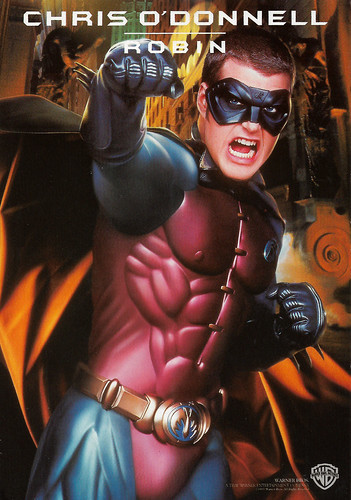
Belgian postcard by Boomerang Free Cards. Photo: Warner Bros. Chris O'Donnell as Robin in Batman Forever (Joel Schumacher, 1995).
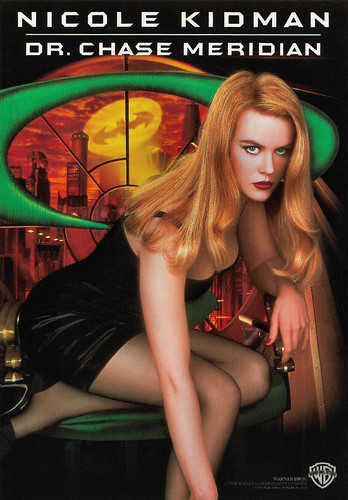
Belgian postcard by Boomerang Free Cards. Photo: Warner Bros. Nicole Kidman as Dr. Chase Meridian in Batman Forever (Joel Schumacher, 1995).
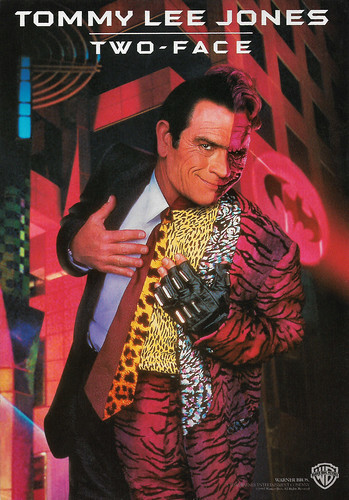
Belgian postcard by Boomerang Free Cards. Photo: Warner Bros. Tommy Lee Jones as Harvey Two-Face in Batman Forever (Joel Schumacher, 1995).
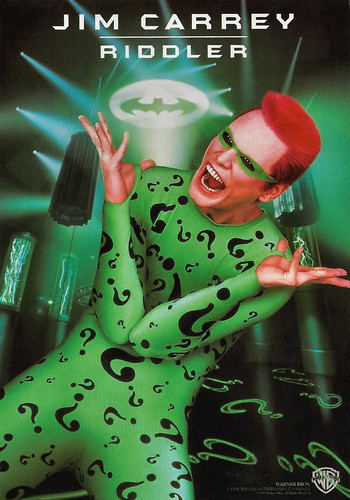
Belgian postcard by Boomerang Free Cards. Photo: Warner Bros. Jim Carrey as Riddler in Batman Forever (Joel Schumacher, 1995).
Sinking his teeth into the super-villain he was born to play
The plot of Batman Forever (Joel Schumacher, 1995) focuses on Batman ( Val Kilmer ) trying to stop a criminal known as Two-Face, formerly district attorney Harvey Dent, (Tommy Lee Jones) and the Riddler (Jim Carrey) in their villainous scheme to extract confidential information from all the minds in Gotham City and use it to learn Batman's identity and bring the city under their control.
The Riddler was formerly Edward Nygma, an eccentric researcher at Wayne Enterprises. Nygma approached his employer, Bruce Wayne (Batman's civilian identity), with an invention that can beam television signals directly into a person's brain. Bruce rejected the device, concerned the technology could manipulate minds. After killing his supervisor and staging it as a suicide, Nygma resigned and plots revenge against Bruce, sending him riddles.
While fighting Two-Face and The Riddler, Batman gains allegiance from a young, orphaned circus acrobat named Dick Grayson (Chris O'Donnell), who becomes his sidekick Robin. Batman also meets and develops feelings for psychologist Dr. Chase Meridian (Nicole Kidman), which brings him to the point to decide if he will lead a normal life or if he is destined to fight crime as Batman forever.
Director Joel Schumacher mostly eschewed the dark, dystopian atmosphere of Tim Burton's films by drawing inspiration from the Batman comic books of the Dick Sprang era, as well as the 1960s television series, but without the campiness of the later film. After Michael Keaton chose not to reprise his role, William Baldwin and Ethan Hawke were considered as a replacement before Val Kilmer joined the cast.
The film was released on 16 June 1995. Batman Forever grossed over $336 million worldwide and became the sixth-highest-grossing film worldwide of 1995. The film received mixed reviews, with criticism directed towards the CGI, Kilmer's performance, costume designs, and tonal departure from previous films, but praising the visuals, action sequences, and performances of Carrey and Jones.
Derek Armstrong at AllMovie : "After two dark chapters that each explored new territory, arguably improving in quality and thematic juiciness with the feminist slant of Batman Returns, Batman Forever sorely misses the presence of Tim Burton and Michael Keaton, who jumped ship before the ideas dried up. It's much more a platform for Jim Carrey than the adequate but dull Val Kilmer , finally permitting Carrey to sink his teeth into the super-villain he was born to play, in turn granting him license to overact his heart out. But for all of Carrey's undeniable gusto, the performance doesn't come close to making the movie."
Roger Ebert at RogerEbert.com : "I liked the look of the movie and Schumacher's general irreverence toward the material. But the great Batman movie still remains to be made. Here is the most complex and intriguing of classic comic superheroes, inhabiting the most visually interesting world, but somehow a story hasn't been found to do him justice. A story - with a beginning, a middle, and an end, and a Batman at its center who emerges as more than a collection of costumes and postures. More than ever, after this third movie, I found myself asking, Who was that masked man, anyhow?"
Batman Forever (Joel Schumacher, 1995) was followed by Batman & Robin in 1997, with Schumacher again as the director. Although Val Kilmer enjoyed playing Batman his working relationship with director Joel Schumacher was poor. Kilmer openly refused to repeat the Bruce Wayne role, and he was succeeded by George Clooney. Chris O'Donnell did return as Robin.
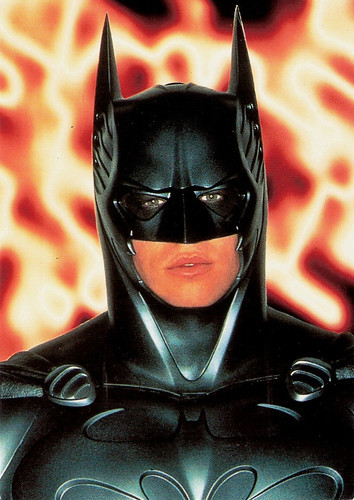
British postcard by Slow Dazzle Worldwide, no 10 in a series of 16. Val Kilmer in Batman Forever (Joel Schumacher, 1995).
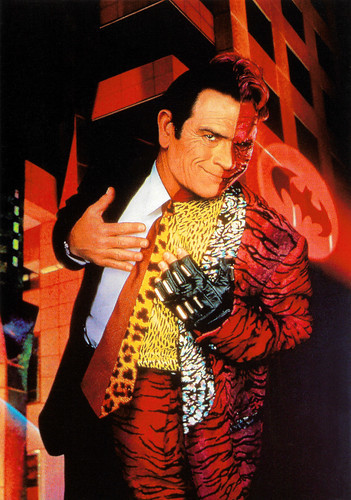
Btitish postcard by Slow Dazzle Worldwide, no. 19 in a series of 16, no. 1621. Photo: DC Comics, 1995. Tommy Lee Jones as Harvey Two-Face in Batman Forever (Joel Schumacher, 1995). Caption: Half man, half madman, he's the ultimate dual personality. Two-Face is the former Gotham City district attorney Harvey Dent, who mistakenly blames Batman for an accident that left one side of his face grotesquely deformed. And now he's out to get Batman!
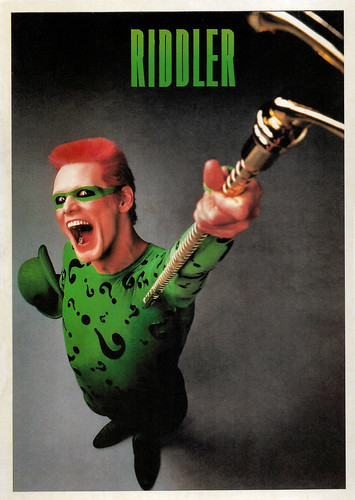
French postcard by Editions Mercuri, no. 1619. Photo: Warner Bros. Jim Carrey as Riddler in Batman Forever (Joel Schumacher, 1995).
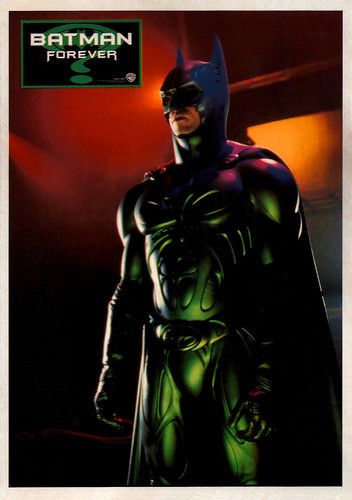
French postcard by Editions Mercuri, no. 1620. Photo: Warner Bros. Val Kilmer in Batman Forever (Joel Schumacher, 1995).
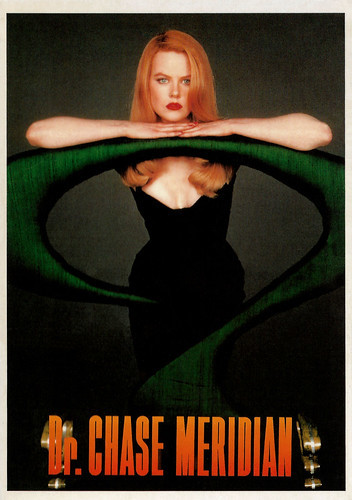
French postcard by Editions Mercuri, no. 1621. Photo: Warner Bros. Nicole Kidman as Dr. Chase Meridian in Batman Forever (Joel Schumacher, 1995).
Sources: Derek Armstrong (AllMovie), Roger Ebert (RogerEbert.com), Wikipedia, and IMDb.

Belgian postcard by Boomerang Free Cards. Photo: Warner Bros. Val Kilmer in Batman Forever (Joel Schumacher, 1995).

Belgian postcard by Boomerang Free Cards. Photo: Warner Bros. Chris O'Donnell as Robin in Batman Forever (Joel Schumacher, 1995).

Belgian postcard by Boomerang Free Cards. Photo: Warner Bros. Nicole Kidman as Dr. Chase Meridian in Batman Forever (Joel Schumacher, 1995).

Belgian postcard by Boomerang Free Cards. Photo: Warner Bros. Tommy Lee Jones as Harvey Two-Face in Batman Forever (Joel Schumacher, 1995).

Belgian postcard by Boomerang Free Cards. Photo: Warner Bros. Jim Carrey as Riddler in Batman Forever (Joel Schumacher, 1995).
Sinking his teeth into the super-villain he was born to play
The plot of Batman Forever (Joel Schumacher, 1995) focuses on Batman ( Val Kilmer ) trying to stop a criminal known as Two-Face, formerly district attorney Harvey Dent, (Tommy Lee Jones) and the Riddler (Jim Carrey) in their villainous scheme to extract confidential information from all the minds in Gotham City and use it to learn Batman's identity and bring the city under their control.
The Riddler was formerly Edward Nygma, an eccentric researcher at Wayne Enterprises. Nygma approached his employer, Bruce Wayne (Batman's civilian identity), with an invention that can beam television signals directly into a person's brain. Bruce rejected the device, concerned the technology could manipulate minds. After killing his supervisor and staging it as a suicide, Nygma resigned and plots revenge against Bruce, sending him riddles.
While fighting Two-Face and The Riddler, Batman gains allegiance from a young, orphaned circus acrobat named Dick Grayson (Chris O'Donnell), who becomes his sidekick Robin. Batman also meets and develops feelings for psychologist Dr. Chase Meridian (Nicole Kidman), which brings him to the point to decide if he will lead a normal life or if he is destined to fight crime as Batman forever.
Director Joel Schumacher mostly eschewed the dark, dystopian atmosphere of Tim Burton's films by drawing inspiration from the Batman comic books of the Dick Sprang era, as well as the 1960s television series, but without the campiness of the later film. After Michael Keaton chose not to reprise his role, William Baldwin and Ethan Hawke were considered as a replacement before Val Kilmer joined the cast.
The film was released on 16 June 1995. Batman Forever grossed over $336 million worldwide and became the sixth-highest-grossing film worldwide of 1995. The film received mixed reviews, with criticism directed towards the CGI, Kilmer's performance, costume designs, and tonal departure from previous films, but praising the visuals, action sequences, and performances of Carrey and Jones.
Derek Armstrong at AllMovie : "After two dark chapters that each explored new territory, arguably improving in quality and thematic juiciness with the feminist slant of Batman Returns, Batman Forever sorely misses the presence of Tim Burton and Michael Keaton, who jumped ship before the ideas dried up. It's much more a platform for Jim Carrey than the adequate but dull Val Kilmer , finally permitting Carrey to sink his teeth into the super-villain he was born to play, in turn granting him license to overact his heart out. But for all of Carrey's undeniable gusto, the performance doesn't come close to making the movie."
Roger Ebert at RogerEbert.com : "I liked the look of the movie and Schumacher's general irreverence toward the material. But the great Batman movie still remains to be made. Here is the most complex and intriguing of classic comic superheroes, inhabiting the most visually interesting world, but somehow a story hasn't been found to do him justice. A story - with a beginning, a middle, and an end, and a Batman at its center who emerges as more than a collection of costumes and postures. More than ever, after this third movie, I found myself asking, Who was that masked man, anyhow?"
Batman Forever (Joel Schumacher, 1995) was followed by Batman & Robin in 1997, with Schumacher again as the director. Although Val Kilmer enjoyed playing Batman his working relationship with director Joel Schumacher was poor. Kilmer openly refused to repeat the Bruce Wayne role, and he was succeeded by George Clooney. Chris O'Donnell did return as Robin.

British postcard by Slow Dazzle Worldwide, no 10 in a series of 16. Val Kilmer in Batman Forever (Joel Schumacher, 1995).

Btitish postcard by Slow Dazzle Worldwide, no. 19 in a series of 16, no. 1621. Photo: DC Comics, 1995. Tommy Lee Jones as Harvey Two-Face in Batman Forever (Joel Schumacher, 1995). Caption: Half man, half madman, he's the ultimate dual personality. Two-Face is the former Gotham City district attorney Harvey Dent, who mistakenly blames Batman for an accident that left one side of his face grotesquely deformed. And now he's out to get Batman!

French postcard by Editions Mercuri, no. 1619. Photo: Warner Bros. Jim Carrey as Riddler in Batman Forever (Joel Schumacher, 1995).

French postcard by Editions Mercuri, no. 1620. Photo: Warner Bros. Val Kilmer in Batman Forever (Joel Schumacher, 1995).

French postcard by Editions Mercuri, no. 1621. Photo: Warner Bros. Nicole Kidman as Dr. Chase Meridian in Batman Forever (Joel Schumacher, 1995).
Sources: Derek Armstrong (AllMovie), Roger Ebert (RogerEbert.com), Wikipedia, and IMDb.
Published on September 27, 2021 22:00
Paul van Yperen's Blog
- Paul van Yperen's profile
- 13 followers
Paul van Yperen isn't a Goodreads Author
(yet),
but they
do have a blog,
so here are some recent posts imported from
their feed.



